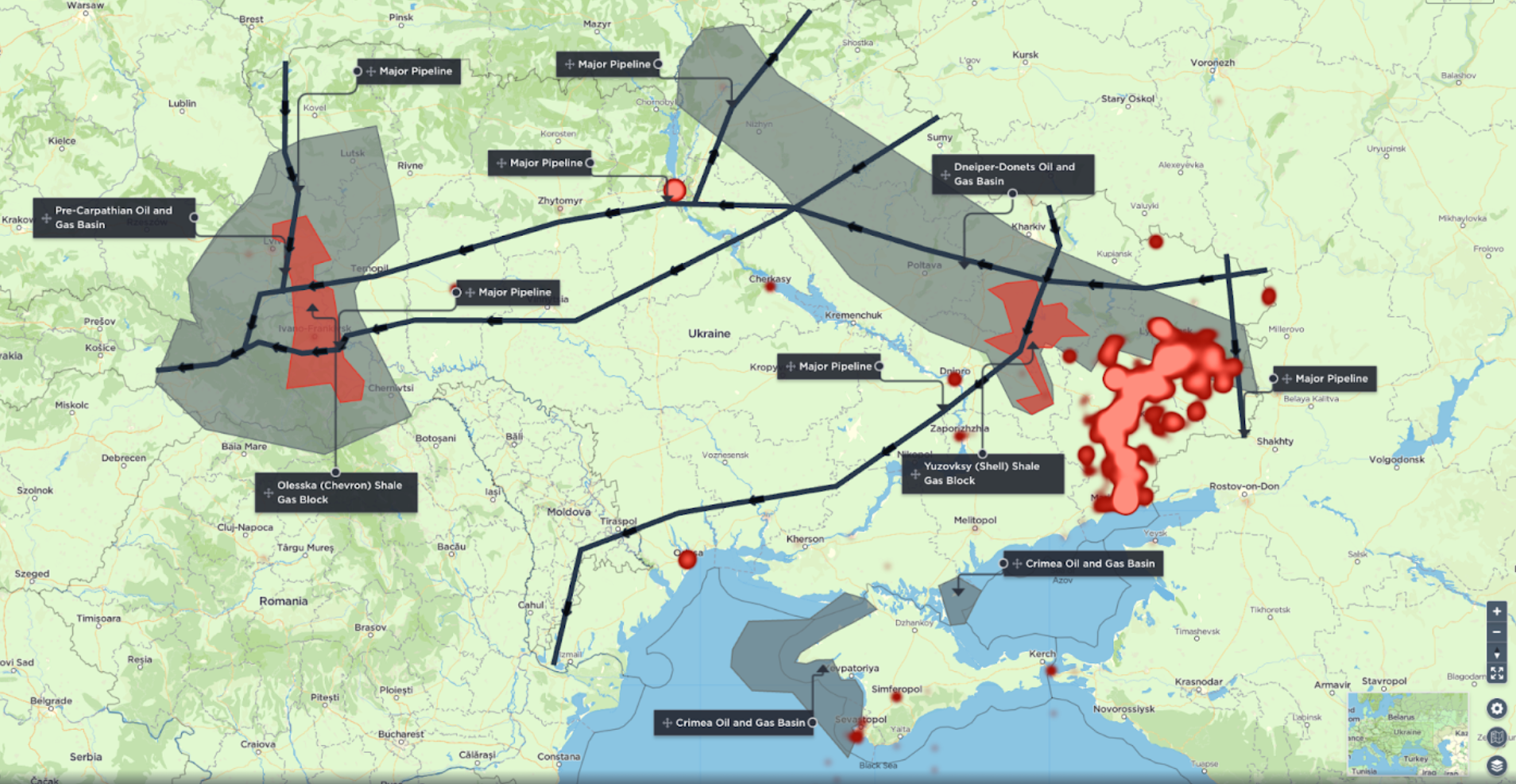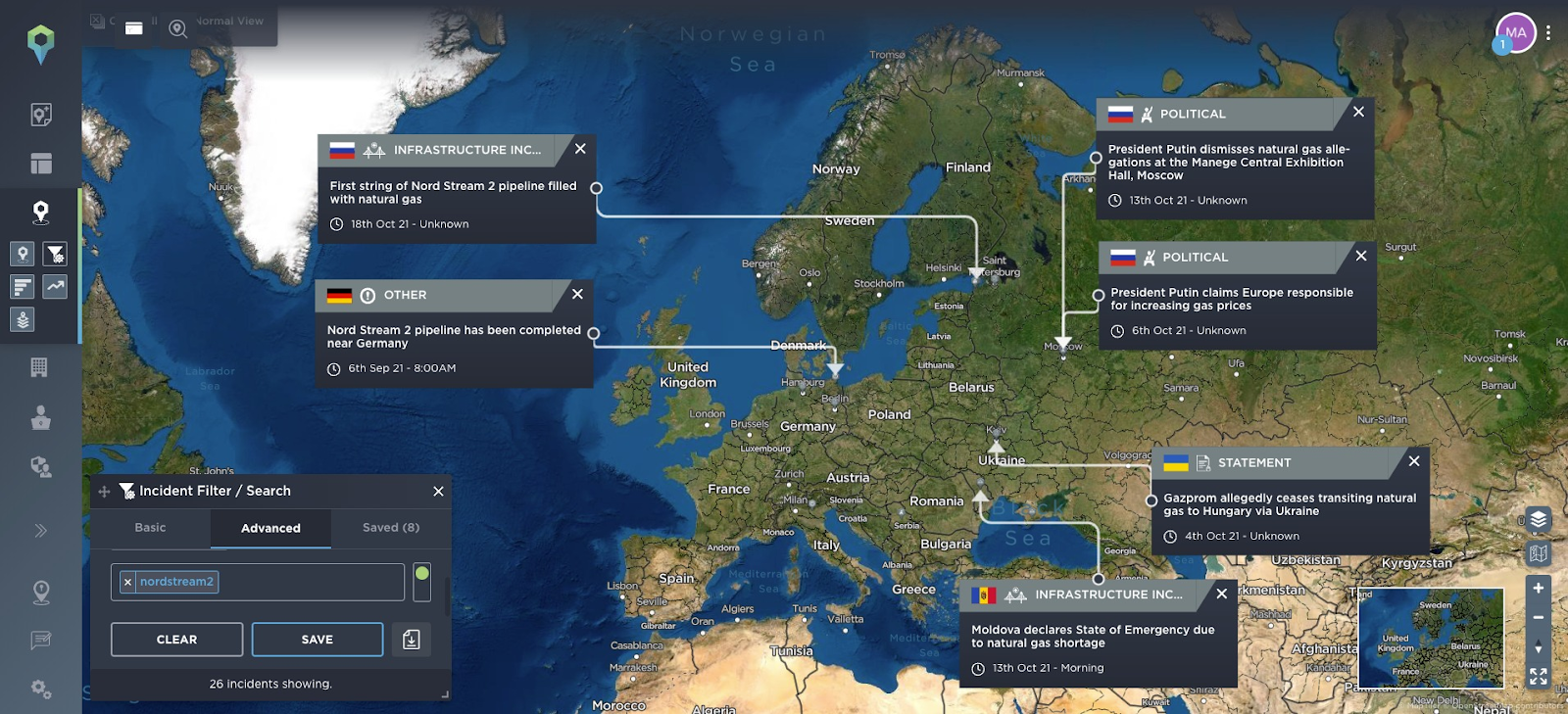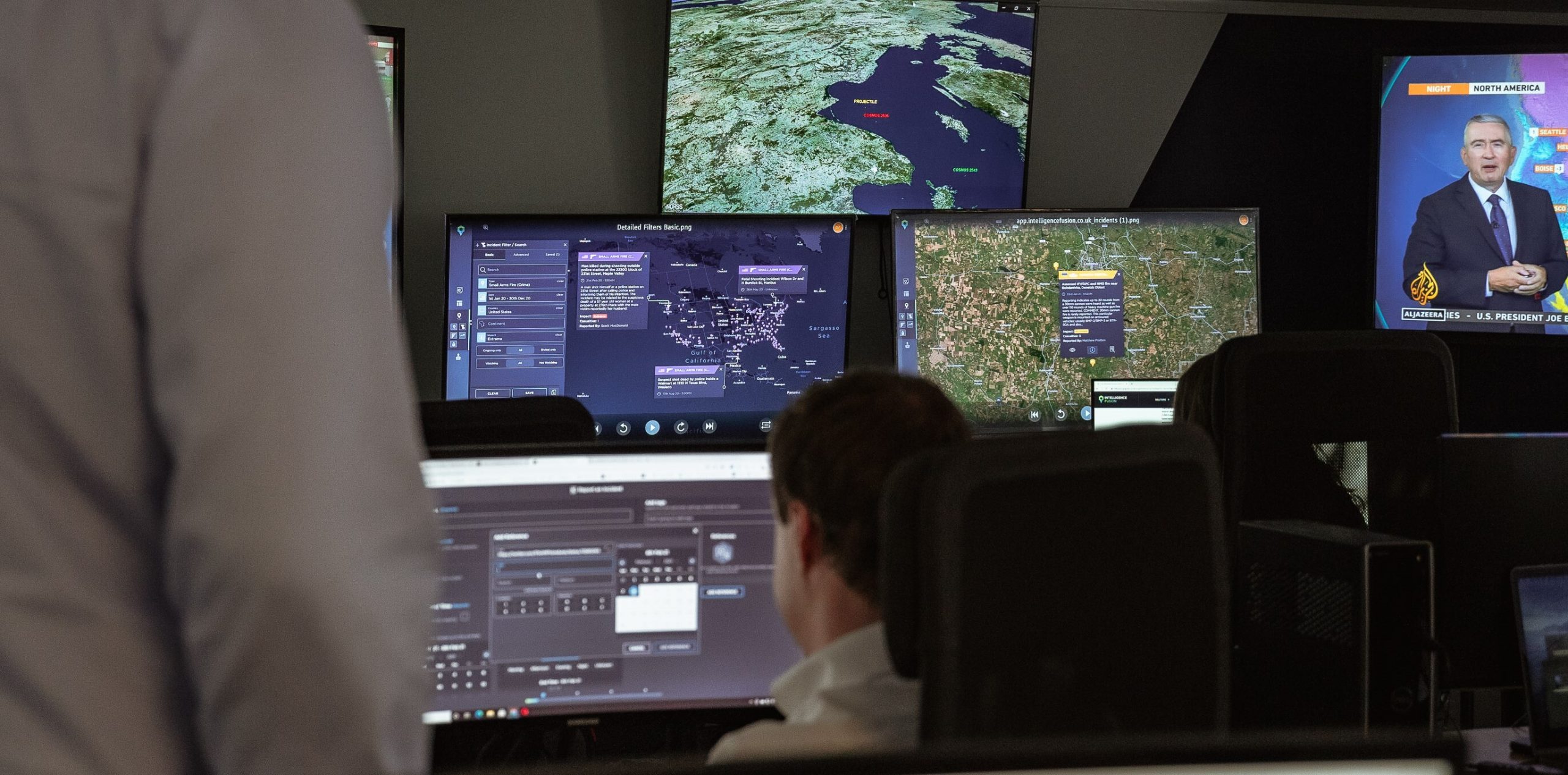Russia-Ukraine Conflict Summary: What’s happening in Ukraine?
Philip Buckingham
Following the Russian invasion of Ukraine, we're taking a closer look at the historical context of the Russia-Ukraine conflict to better understand the escalation as well as providing you with a detailed timeline of events, documenting the latest developments and our short-term assessment of what to expect in Ukraine and beyond.
What's happening in Ukraine?
Prior reporting from Intelligence Fusion on the Russia-Ukraine conflict in the Donbass region revealed consistent reports of ceasefire violations and withdrawal agreements from both Russia-backed DPR and LPR (Donetsk and Luhansk People’s Republic) separatists and Ukrainian forces.
These ceasefire and withdrawal violations have been a constant feature of our reporting for some time now, with rhetoric and actions periodically escalating but neither side escalating to the point of outright warfare as seen prior to the Minsk Agreements of 2014-15.
However, on the 24th February 2022, Russia launched an invasion of Ukraine. The development came after Russian President, Vladimir Putin, ordered a “specialised military operation” that aimed to demilitarise the country. Since then, the conflict has escalated significantly and continues to be fast-changing.
This report will take a look at the context surrounding the reported troop build-up on Ukraine’s borders, and act as a living document, with periodical updates on the Russian invasion of Ukraine.
Get regular intelligence updates on the Russian invasion of Ukraine
With Russia having now launched an invasion of Ukraine, get regular updates on this fast-moving situation. We’re covering the conflict 24/7, so to provide you with a full run-down of developments, and our most up-to-date assessment, we’re circulating regular intelligence summaries.
Head here to sign-up for our regular reports
What happened in the lead up to the Russian invasion of Ukraine?
Without going back to the beginning of the conflict, we revisit an Intelligence Fusion report from November 2021 that provided key insight into the ongoing Poland-Belarus Border conflict, Russia’s involvement and what that meant for already increasing tensions in the Donbass region.
In an intelligence report dated 24th November 2021, Senior Regional Analyst for Europe, Matt Pratten noted the following:
“Reports used to log ceasefire violations in Donbass often provide good information (for open sources) on the dates, times and locations of incidents; but little to no indications of who is responsible for ceasefire violations. Separate, on-the-ground reporting has provided greater insight into ceasefire violations in this regard.
The Russia-backed separatists have reportedly been frequently trying to force Ukrainian forces to retaliate in order to create the perception among local nationals and the international community that Ukrainian forces are not complying with the Minsk II agreement. If this narrative is accepted, the separatists – in some cases fighters directly from Russia – can then launch an offensive to solidify/increase their gains in Donbass.
Greater control of the Donbass region by Russia or its proxies would help strengthen Russian territory in the south – both the Volgograd gap to exposing access to the Caspian Sea and its hold on Crimea – and gain greater control over the oil, gas and mineral resources in Donbass.”
Russia previously made repeated claims of Ukrainian aggression; on 10th December, for instance, the Russians claimed that a Ukrainian naval vessel had attempted to cross into the Kerch Strait from the Azov Sea. Claims of violation of sovereignty is a common complaint from Moscow – in June 2021, for example, the Russian Government made claims of Royal Navy’s HMS Defender entering Russian waters near Sevastopol which was later reported by Western sources as being based on falsified location data. When viewed alongside the reported provocation from the Russian-backed DPR/LPR forces in Donbass, this behaviour was perceived by many commentators as further attempts to find justification for Russia to take action against Ukraine.
The same report noted a significant build-up of Russian forces on Russia-Ukraine borders:
“While the Poland-Belarus border has been dominating open source reporting, significant activity has been noticed in the Donbass region from October. There have been reports of Russian military movements in its regions close to Ukraine; including a convoy of SS-26 Stone Ballistic missiles and TOS-1A Flamethrowers. Russian armour and artillery has been sighted on rail transports and BM-21 Grad multiple barrel rocket launch systems operated exclusively by Russian forces have been sighted within Donetsk Oblast. Separate reporting alleges up to 92,000 troops have been amassed around Ukraine’s borders. This is the second time this kind of activity has happened, but reports for logging these incidents – supported by contextual reporting – suggest that Russian military assets have been moved to the border in a more covert manner this time around. The nature of these movements have sparked concerns that Russia could be planning another offensive into Ukraine to take full control as early as January 2022.”
Following our analysis, the build-up was highlighted in widespread media reporting, with the potential for Russia to invade Ukraine becoming a hot topic for mainstream media sources. This was bolstered in the early days of December, with US Secretary of State Antony Blinken stating at a NATO ministers meeting on 1st December that there is “evidence that Russia has made plans for significant aggressive moves against Ukraine”, and with the Kremlin saying on 2nd December that ‘the probability of a new conflict in eastern Ukraine remained high’, saying that Moscow was concerned by “aggressive” rhetoric from Kyiv. Oleksiy Reznikov, Ukraine’s Defense Minister, told Ukraine’s Parliament on 3rd December that “the probability of large-scale escalation from Russia exists” and that late January would be the most likely period for the escalation in Donbass to take place – adding, however, that “the escalation is a possible scenario, but not the inevitable one”.
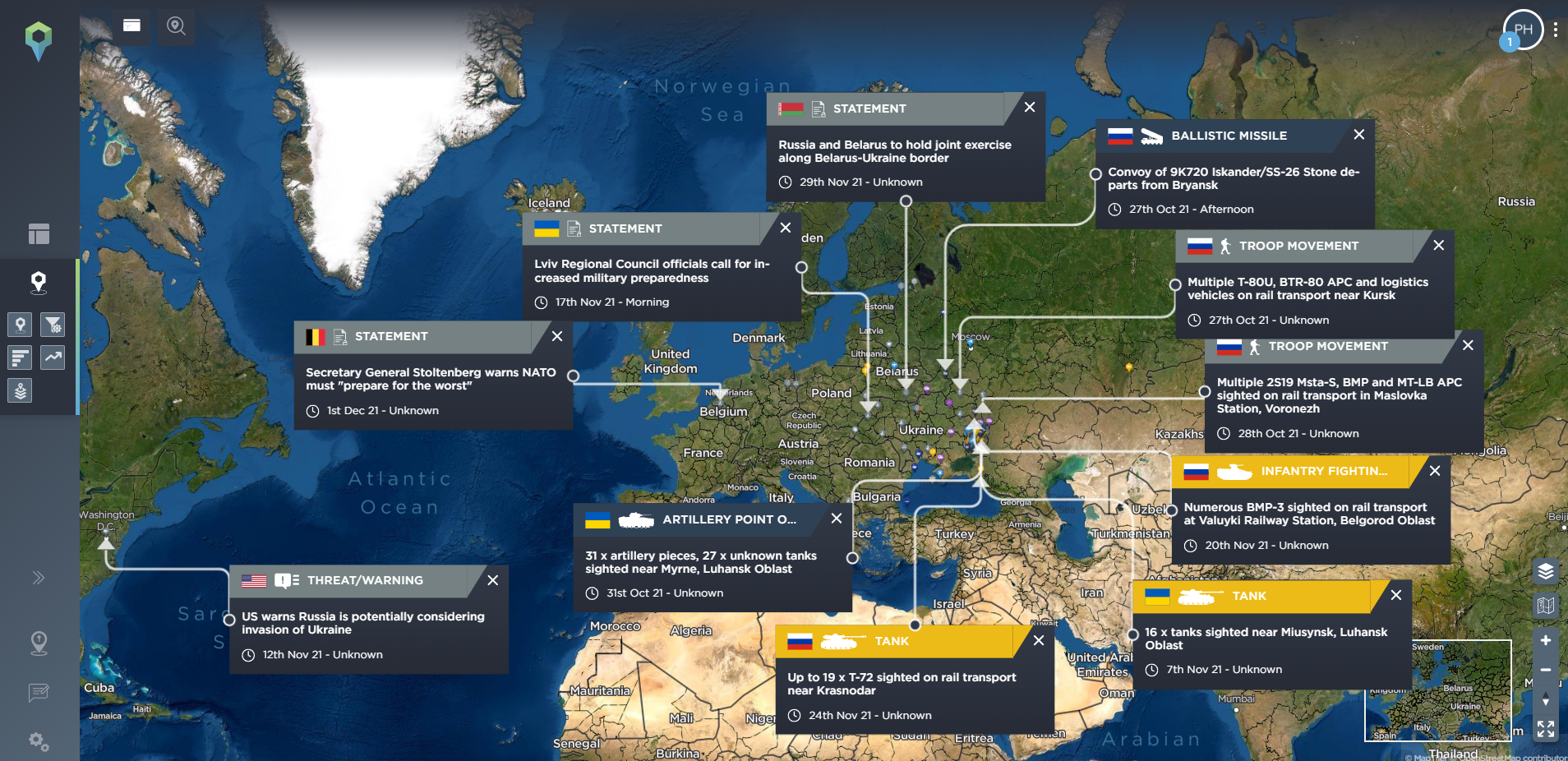
Recent developments in the Russia-Ukraine conflict as of 10th December 2021 [Source: Intelligence Fusion]
What triggered the invasion of Ukraine?
Having monitored the increasing volatility between Russia and Ukraine for some time, we look back on the activity that led to commentators predicting the invasion of Ukraine.
Prior to Russia invading Ukraine, troop build-ups had been reported multiple times that ultimately acted as a bluff or form of muscle flexing from Moscow rather than being the first steps towards a Russia-Ukraine war. The most notable or recent example of a troop build-up took place between March and April 2021, when Russia deployed a high level of troop, artillery and military vehicle, and even naval movement into the region. On that occasion, Defence Minister Sergei Shoigu eventually instructed Commanders to return their units to their respective bases; stating the ‘snap inspection’ objectives had been achieved.
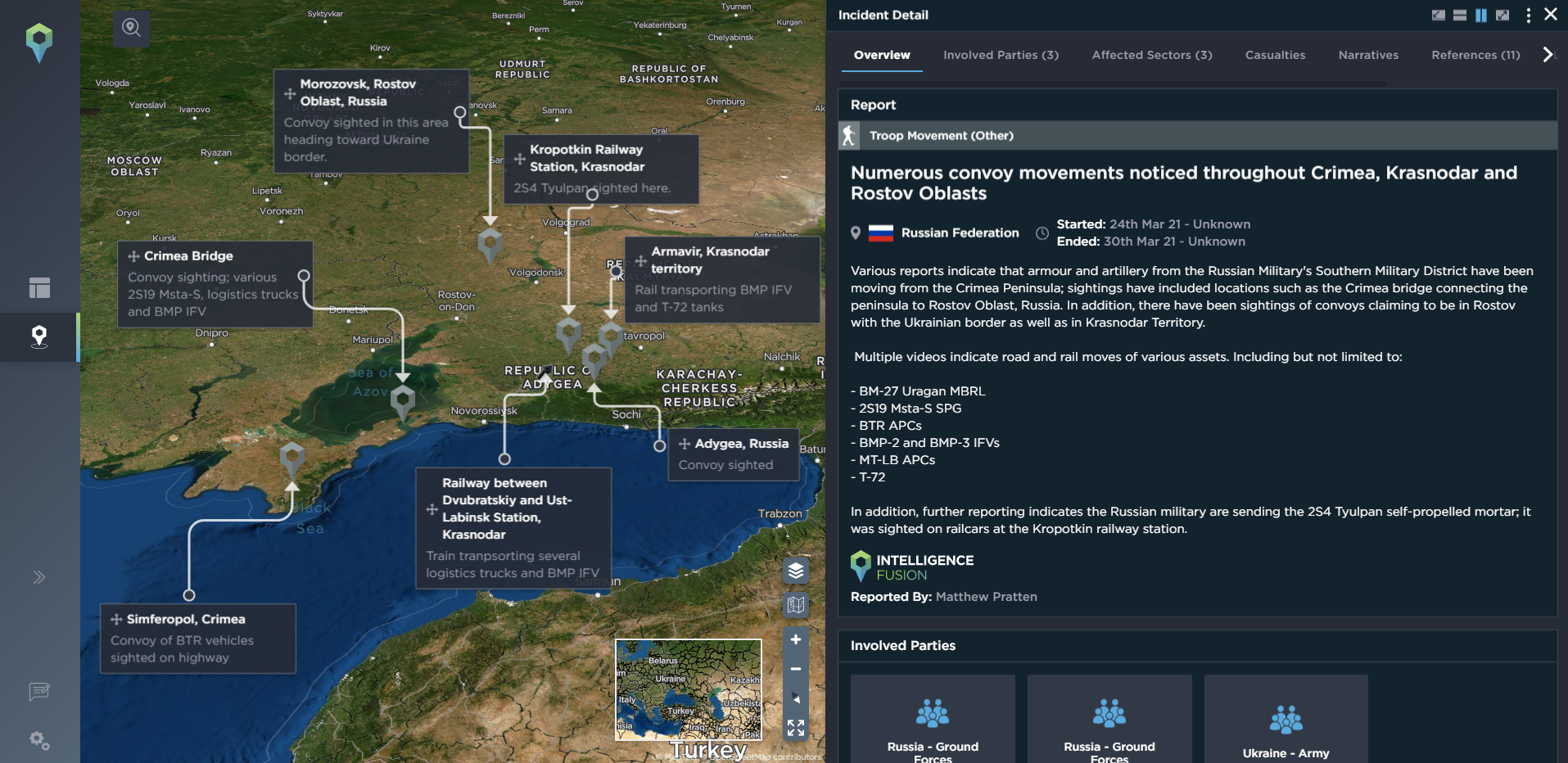
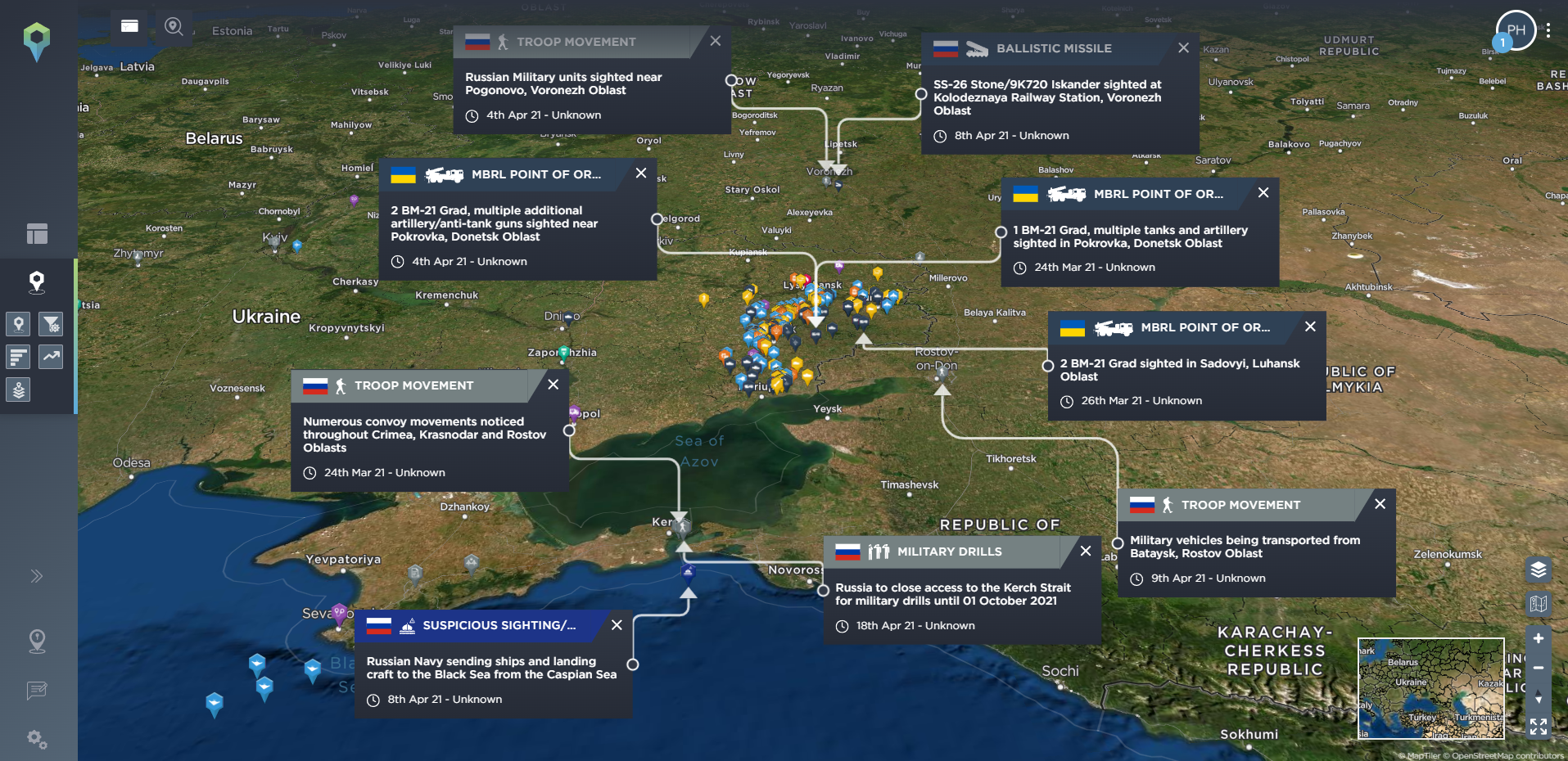
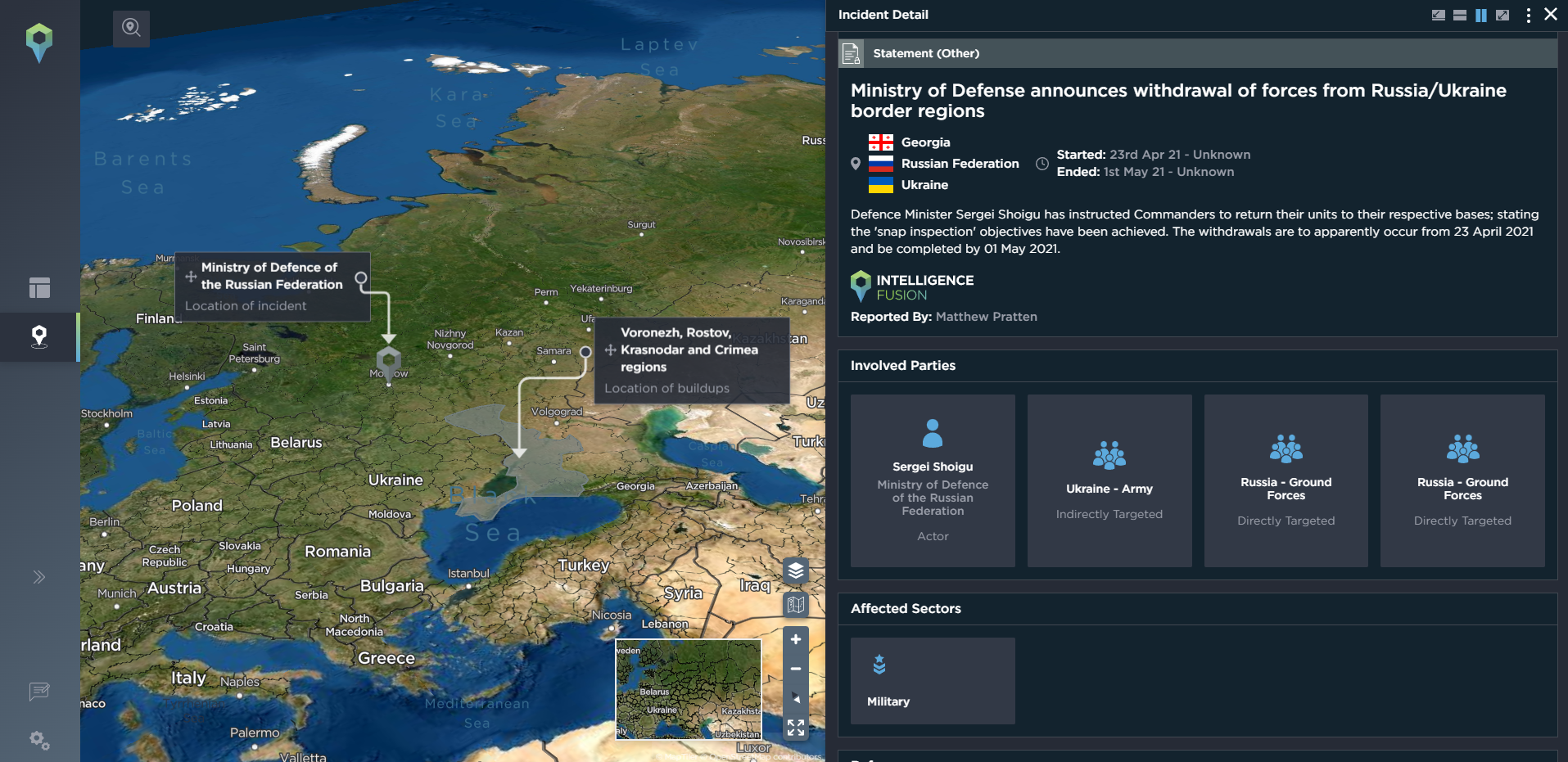
Reporting on a previous build-up of Russian troops near the Ukraine border from spring 2021. Troop movements were readily available to track through open-source reporting in contrast to the early troop movements of this most recent build-up [Source: Intelligence Fusion]
The Russia-Ukraine Conflict: December Update
Intelligence released in December 2021 by the Ukrainian military suggested that the preparation for a potential Russian invasion of Ukraine was underway. Our update from the 10th December 2021 expands on the intelligence available and the international response at that time.
In the map below the Ukrainian military highlighted the strength of Russian forces on its borders with Belarus and Russia to the North, East and South of the country.
According to the statement made by Oleksiy Reznikov on the 3rd December, there were 94,300 Russian army servicemen on Ukraine’s border and in separatist occupied territory in Donbass.
In early December, US President Joe Biden stated that the US would take a more direct role in diplomacy in the region, in an attempt to dissuade Russia from a potential invasion. On 8th December, President Biden warned of severe consequences if Russia did invade, but that putting American troops on the ground in Ukraine “is not on the table”. Instead he said that there would be “economic consequences like none [Russian President Vladimir Putin] has ever seen”. In the same conversation President Putin refused to say whether he would order troops into Ukraine.
In a report dated 9th December, the Associated Press cited anonymous US administration officials, who reportedly suggested that “the U.S. will press Ukraine to formally cede a measure of autonomy to eastern Ukrainian lands now controlled by Russia-backed separatists” in an attempt to resolve the situation peacefully. According to former US ambassador to Ukraine, Steven Pifer, this could include allowing the separatist-controlled Donbass region to control its own health care, police and schools.
The Russia-Ukraine Conflict: January Update
As of the 27th January, troops continued to mass on the border of Ukraine, often under the guise of ‘military drills’ such as the ‘United Resolve’ joint Russia-Belarus drills that take place between the 10th-20th February. Our update on the Russia-Ukraine conflict from January 2022 describes the efforts from the West to discourage an invasion as well as the increase in cyber attacks witnessed prior to the invasion.
Ukrainian intelligence figures on 19th January suggested that over 127,000 troops are stationed near to its borders, from Belarus to the North, Crimea to the South and Russia to the East, not far from the ongoing civil war in the Donbas region, with sources in Ukraine suggesting that Russia has “almost completed” its buildup.
The West, for its part, continues to send military aid to Ukraine, including 90 tons worth of US military ‘lethal aid’, anti-armour and defensive weapon systems from the UK, and US-made weapons from the Baltic countries, while Ukraine has also previously bought weapons from Turkey including Bayraktar TB2 drones that were used against the separatists in Donbas in October. Sweden has also moved troops to the island of Gotland, the closest part of Sweden to Russia, while on 24th January, the Pentagon stated that roughly 8,500 American troops have been put on heightened alert in the US in case NATO activates its Response Force, and on 25th January UK Prime Minister Boris Johnson said that the UK “would look to contribute to any new NATO deployments to protect our allies in Europe” should Russia invade Ukraine.
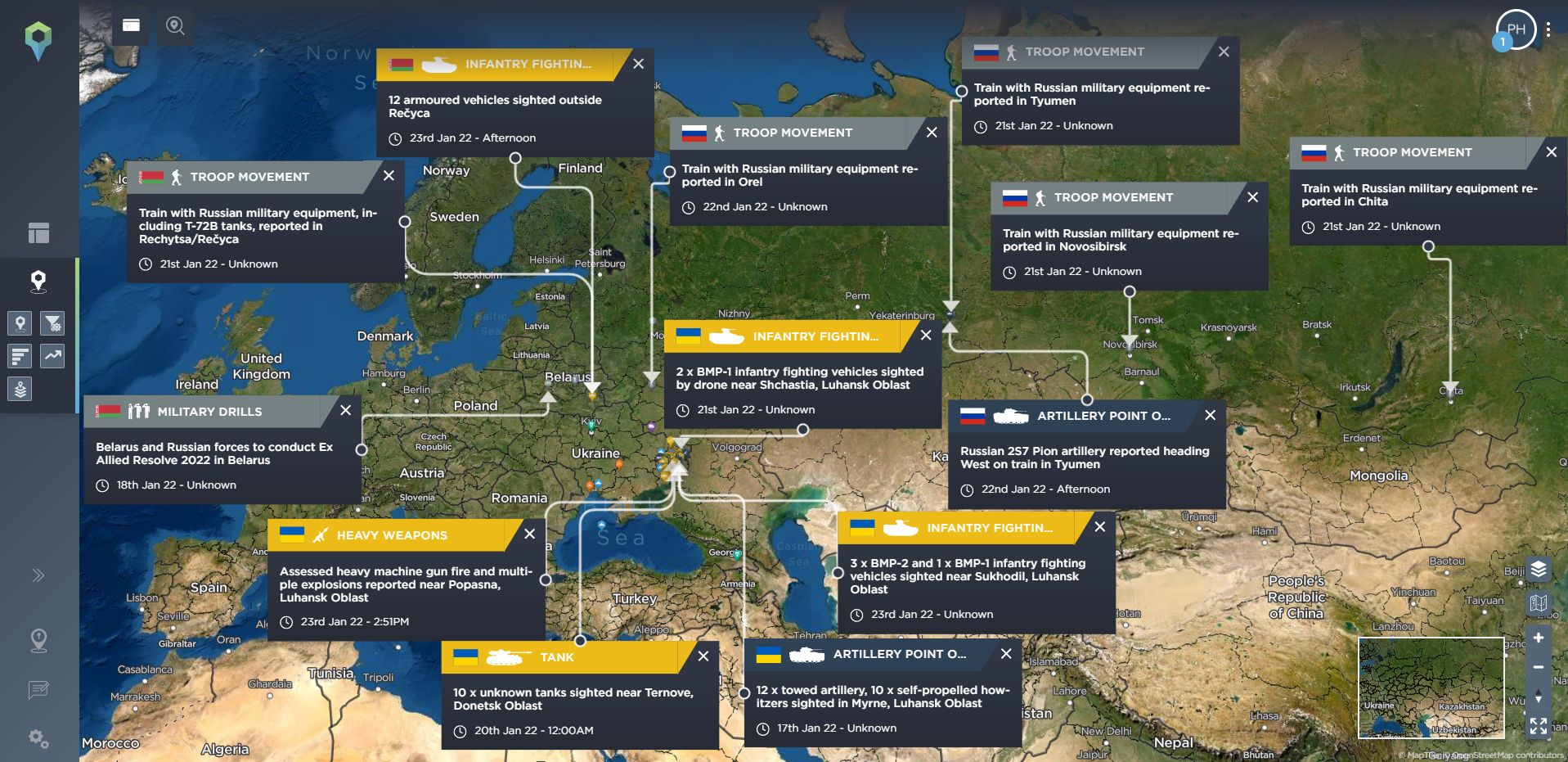
Open-source reporting shows that troops and military equipment continue to be sent to Ukraine’s borders as well as being spotted in the region of the Donbas conflict [Source: Intelligence Fusion]
Western powers have also taken the unusual step of publicly releasing intelligence in an attempt to pre-empt alleged Russian subterfuge related to a potential Russian invasion of Ukraine. On 14th January the US stated that Russia may be planning ‘false flag’ attacks in an attempt to justify or create a pretext for invasion – as mentioned above, there are already reports of attempts to provoke a reaction from Ukraine forces in Donbas, to create a justification to invade. The UK, meanwhile, released a public statement on 22nd January stating that Russia plans to install a puppet pro-Russian government with former Ukrainian MP Yevhen Murayev being considered as a potential candidate.
In addition to the troop buildup, other events of note include a mass cyber attack on Ukrainian government and embassy websites on 14th January – cyber warfare is a common course of action, with botfarms routinely shut down across Ukraine.
On 25th January, Ukraine stated it had dismantled a Moscow-backed criminal group that was preparing a series of ‘armed attacks’ on city infrastructure, coordinated by Russian special service – saying that the group was planning a series of armed robberies, with raids uncovering a bomb, guns and ammunition.
On the morning of 27th January, meanwhile, a Ukrainian National Guard serviceman armed himself with an AK-47 and 200 rounds of ammunition and shot guards at the Yuzhny Machine-Building Plant Yuzhmash in Dnipro – reportedly a state-owned rocket and space equipment manufacturing plant, killing four soldiers and a civilian, with five others injured. At the time of writing, it was believed that the 20-year-old suspect had fled and a large-scale police operation has been launched in the region to locate him.
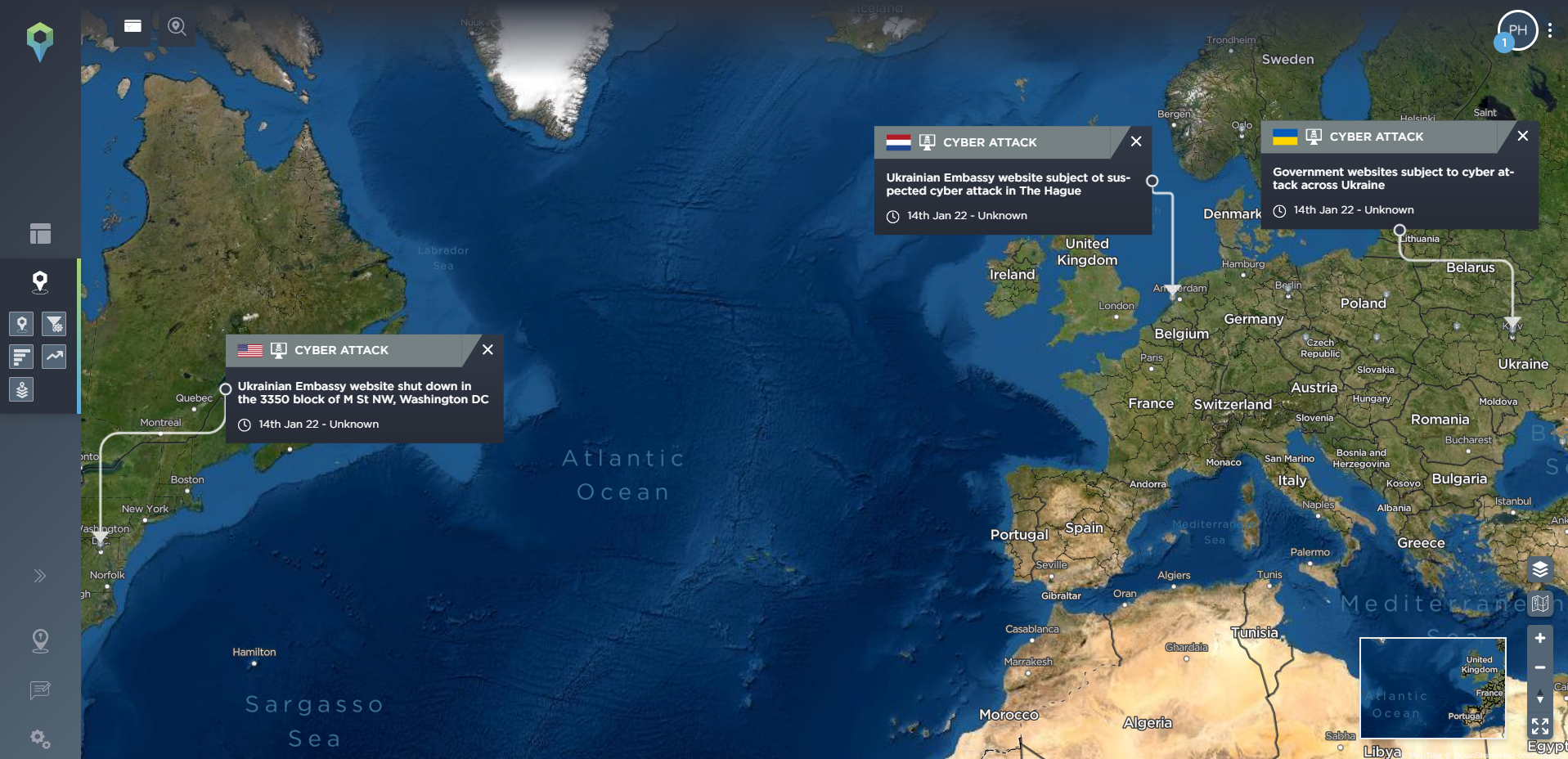
A massive cyber attack targeted Ukrainian government and embassy websites on 14th January [Source: Intelligence Fusion]
Russia-Ukraine Conflict Update: February Update
Since the previous update on 27th January 2022, incidents relating to the Russia-Ukraine conflict continue to be logged across Ukraine and along its borders with Russia and Belarus.
What’s the latest from Ukraine?
As of the 15th February, activity within or around Ukraine’s borders has continued to be high, not just in terms of Russian troop movements, but also in terms of activity in Eastern Ukraine’s disputed Donbas region.
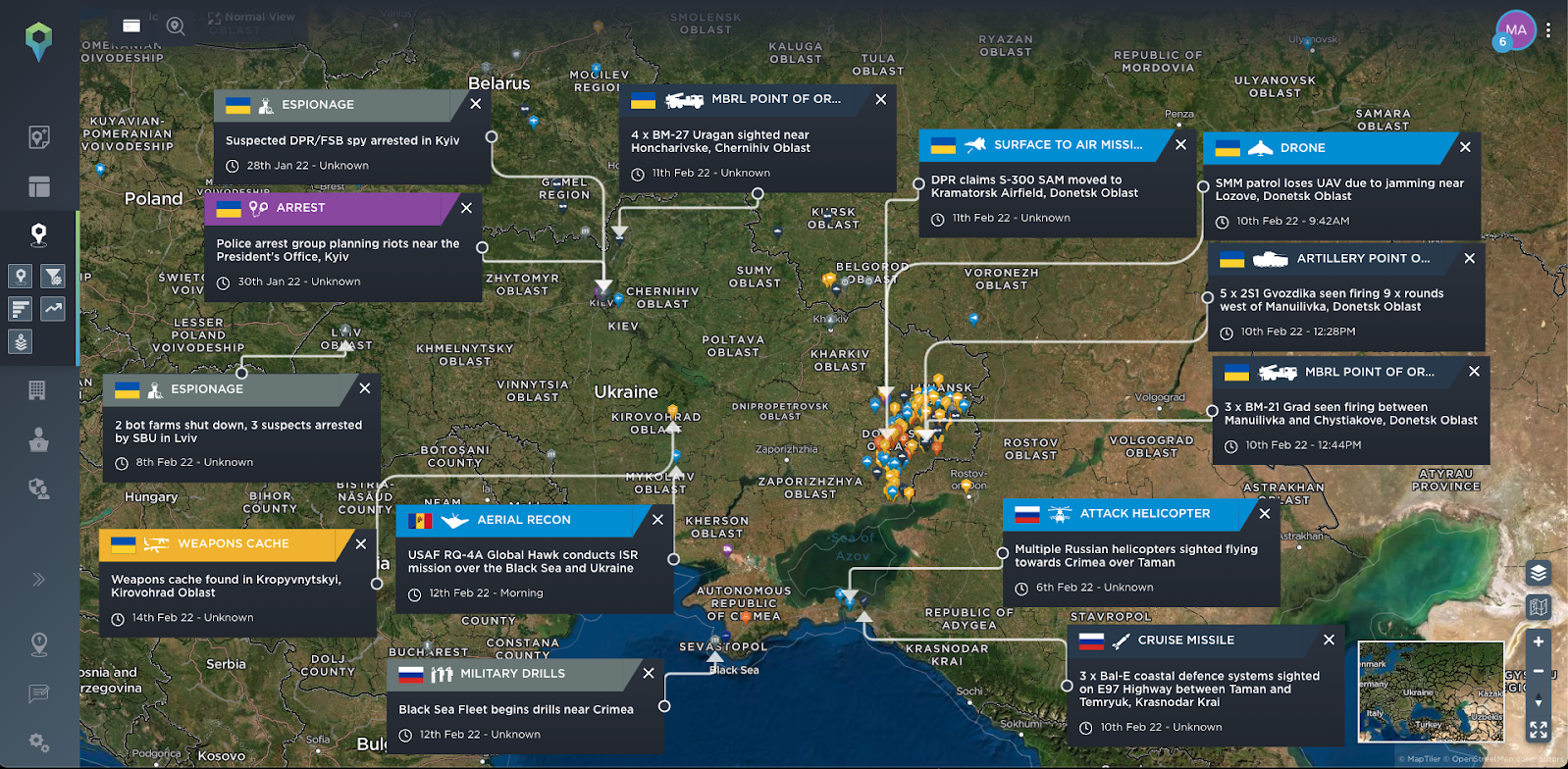
Figure 1: Incidents and significant activity within Ukraine as of 15th February 2022 [Source: Intelligence Fusion]
Elsewhere, Ukraine’s Security Service continued to arrest suspected Russian intelligence assets, shut down reported bot farms operating thousands of fake social media accounts and a group that was allegedly planning to cause unrest in Kyiv. Additionally, Ukrainian forces appeared to have been positioning artillery near its border with Russia in what appears to be the anticipation of Russian forces crossing into Ukraine from the north amongst numerous other preparations by Ukrianians in Kyiv.
Belarus
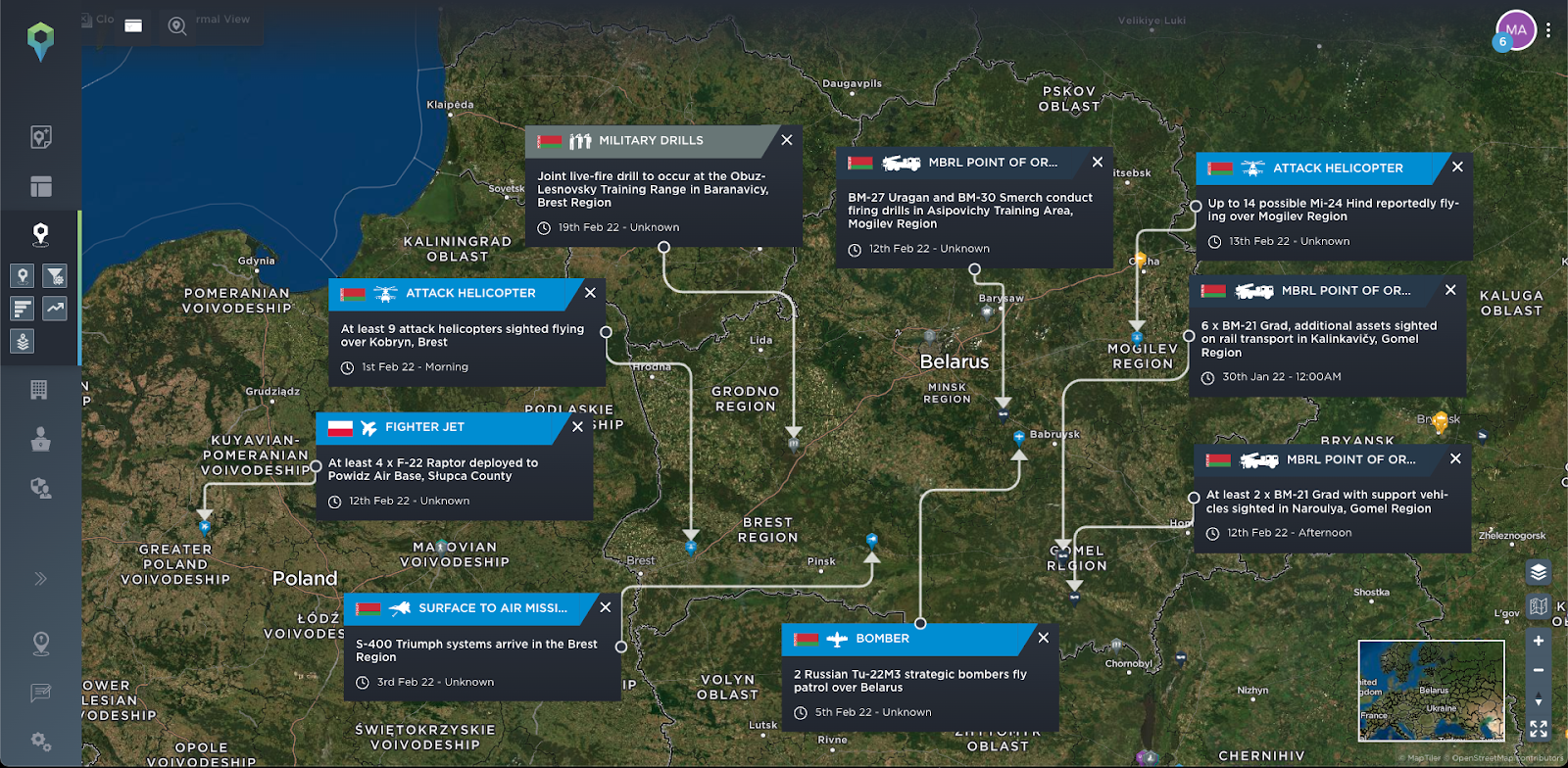
Figure 2: Incidents and significant activity within Belarus as of 15th February 2022 [Source: Intelligence Fusion]
Reporting on this asset claimed that the S-400 can destroy (depending on the missile used) up to a range of 400km against a variety of aircraft. With this kind of placement and alleged capability, such air defence may be problematic to the USAF F-22 Raptors which recently arrived in Poland.
Russia
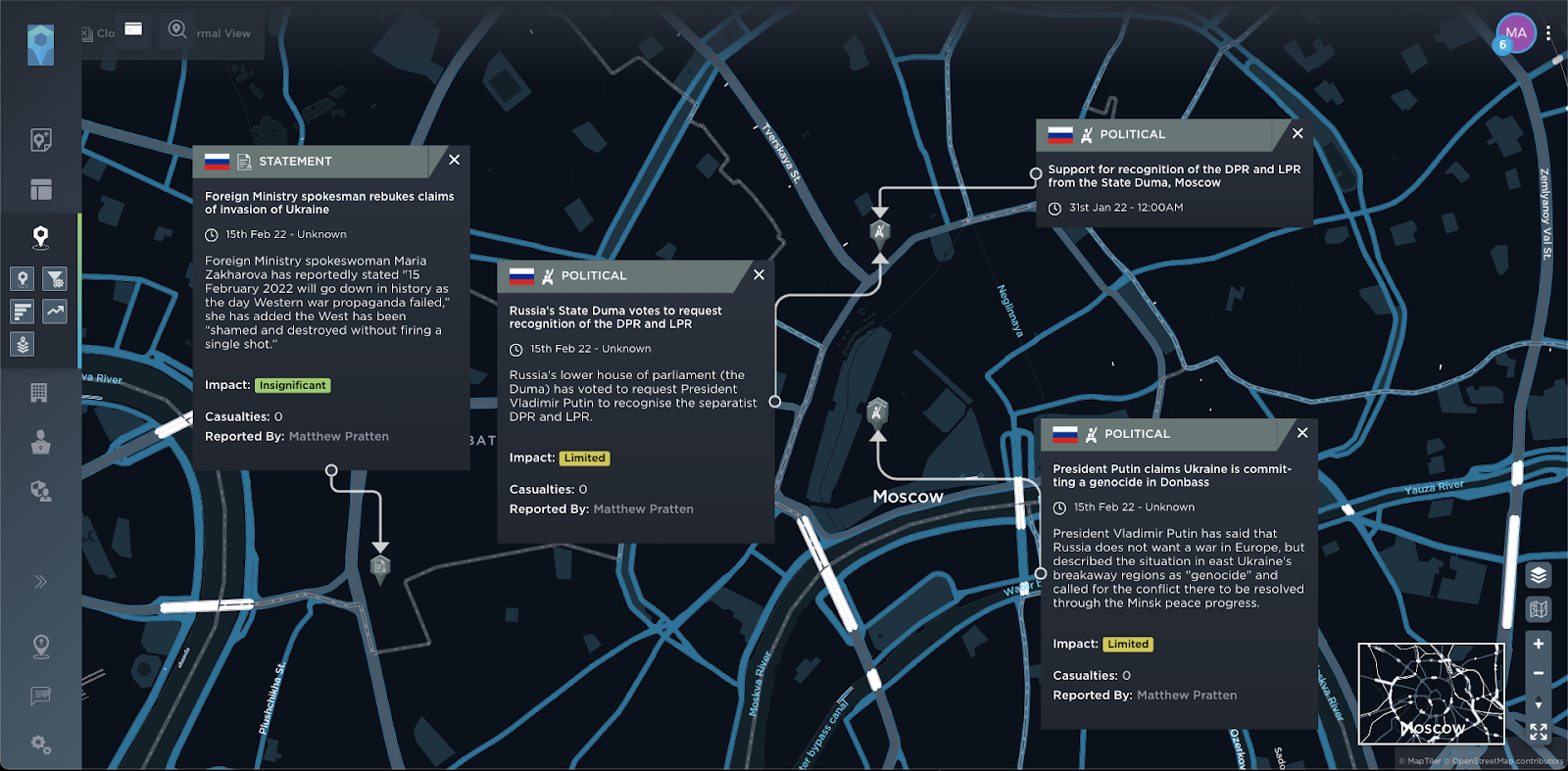
Figure 3: Significant political activity within Russia as of 15th February 2022 [Source: Intelligence Fusion]
During the various meetings President Putin has had with European leaders, Russian Foreign Ministry officials have been making statements that mocked the claims of invasion. Coinciding with these incidents was a recent vote by Russia’s State Duma (Parliament) to recognise the DPR and LPR separatists in Donbass. The vote did not appear to have been ratified by President Putin at the time of reporting but he has claimed a genocide is occurring in Donbass.
Considering the practice of granting Russian citizenship to people in Donetsk and Luhansk since invading in 2014 and the similar casus belli used for that invasion, at the time of writing we saw the potential for Russia to manufacture circumstances which would see further incursions into Ukraine take place in Donbass alongside the DPR and LPR forces on the basis of the ‘Responsibility to Protect’ – a doctrine which has been frequently used for military action under the auspices of the United Nations.
What are Russia’s intentions?
As of the 15th February, reports continued to show growing tensions in the Donbass region. However, much of the activity did not support an anticipated invasion of Ukraine along its northern border as some open-source reporting had suggested. However, we believed that such an outcome remained a possibility with the window of opportunity – Exercise Allied Resolve 2022 from 10th-20th February 2022 – beginning to close.
What we thought could change is how a potential invasion could occur. Rather than from the north straight to Kyiv, it could possibly come from the east into the Donbass region alongside DPR and LPR forces, potentially using a casus belli based on the Responsibility to Protect doctrine.
On the 21st February 2022, Russian President Vladimir Putin agreed with a recent vote by the State Duma and formally recognised the separatists in Donetsk and Luhansk Oblasts of Ukraine
At the time of reporting, the most recent development in the fast-moving Russia-Ukraine crisis came as President Putin officially recognised the Donetsk and Luhansk regions as independent states (the Donetsk People’s Republic and Luhansk People’s Republic – or DPR and LPR respectively). Alongside this recognition was an order to send troops into these regions to ‘perform a peacekeeping function’.
This decision by President Putin came at a time where fighting in the Donbass region between Ukrainian forces and the Russia-backed DPR and LPR had increased. In the week prior to this, there had been a significant increase in ceasefire violations and several incidents where DPR, LPR and Russian forces claimed that Ukraine had carried out car bomb attacks, indirect fire attacks along the Russian border and two Ukrainian BMPs had attempted to cross into Rostov Oblast. Such claims by separatists and Russia were in line with ‘false flag operations’ to manufacture claims of Ukrainian aggression.
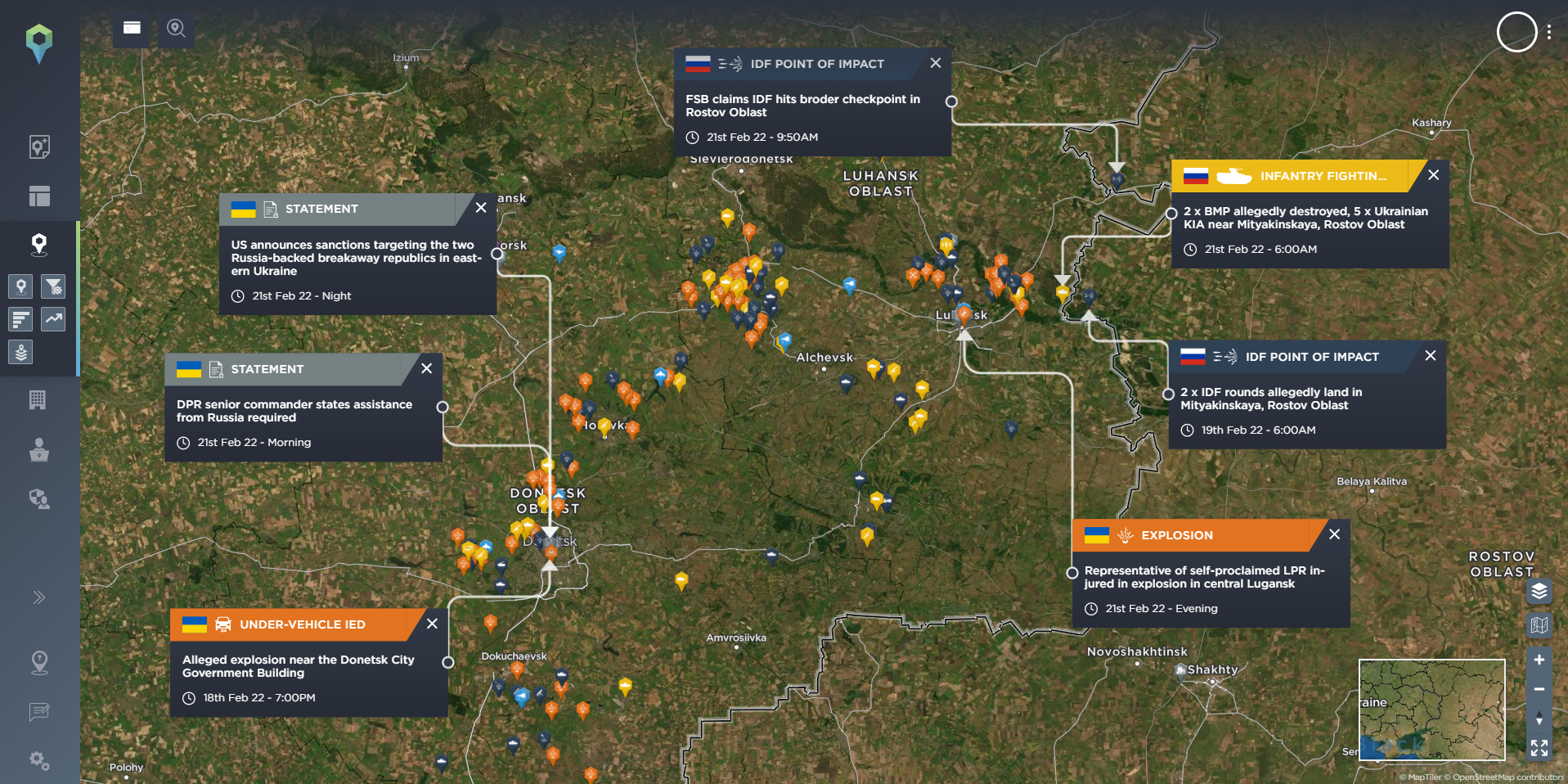
At the time, we believed that the decision to recognise the DPR and LPR separatists and the deployment of troops into Ukraine, separatist forces would probably begin to be reinforced with additional weaponry; likely to be tanks and artillery. While the Russian deployment would likely see a brief pause in fighting, more claims of Ukrainian aggression would likely be manufactured. Following these claims, fighting will further intensify.
On 22nd February, Ukraine’s SBU published details alleging LPR and DPR communications that include:
“admitting to each other that they are organizing provocations and shelling civilians;
discussing the accumulation of Russian troops, including the involvement of Chechens in the Kadyrov Regiment;
are surprised that the Armed Forces are not being led by provocative shelling of militants;
it is said that the militants themselves hit “a booth in Russia” (later the FSB called it “shelling of the Russian border checkpoint in the Rostov region”);
confirming that their shells hit the Luhansk TPP (as a result of which the city of Schastia was left without electricity, water and heat)”
These details appeared to be linked to several incidents which Russia would use as ‘casus belli’ for its deployment of forces.
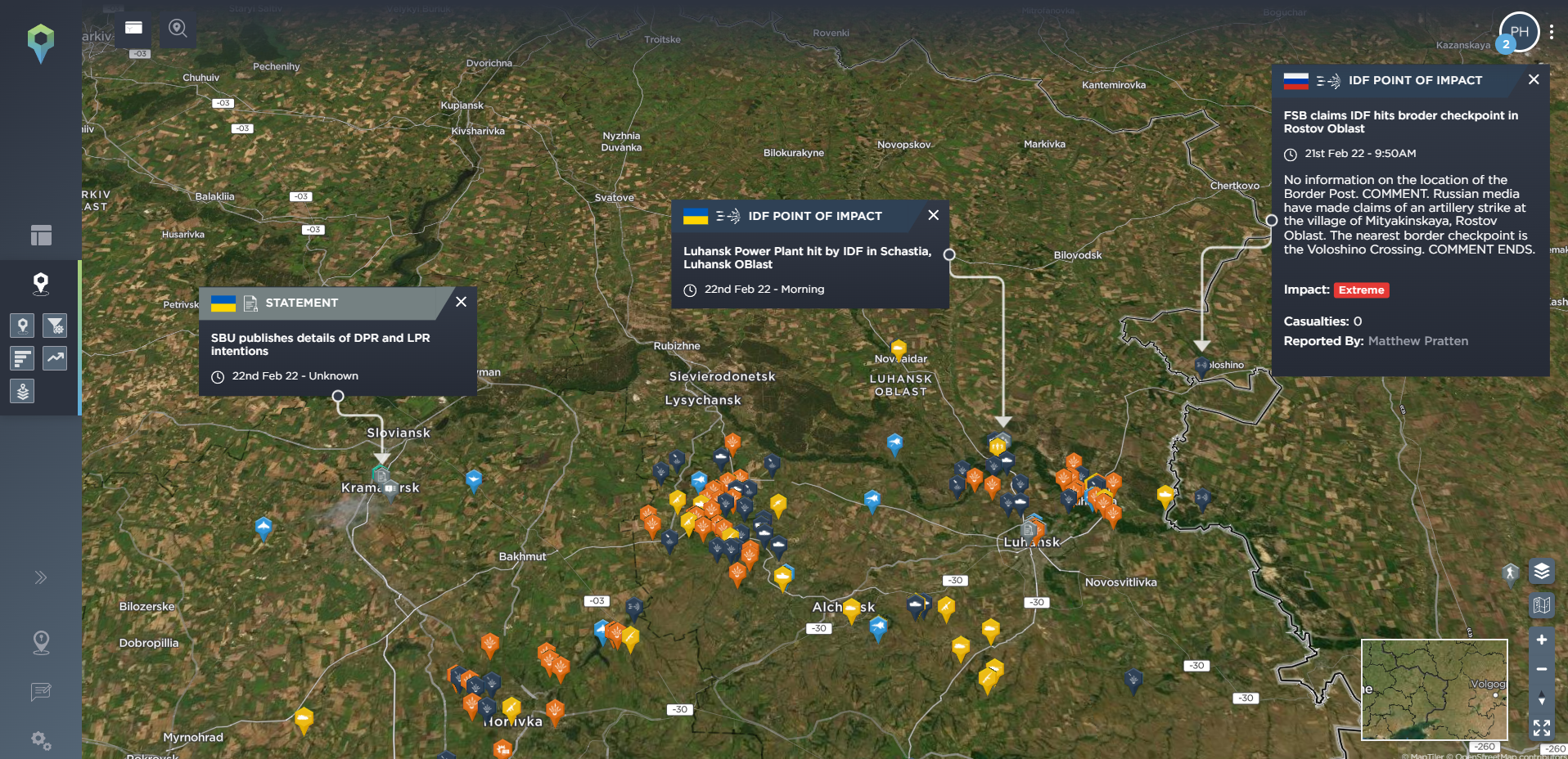
Russia-Ukraine Conflict: After the Invasion
On 24th February 2022, Russia launched an invasion of Ukraine. The development came after Russian President, Vladimir Putin, ordered a “specialised military operation” that aimed to “demilitarise the country.” This section provides a timeline of events since Russian began an attempt to invade Ukraine.
24th February 2022
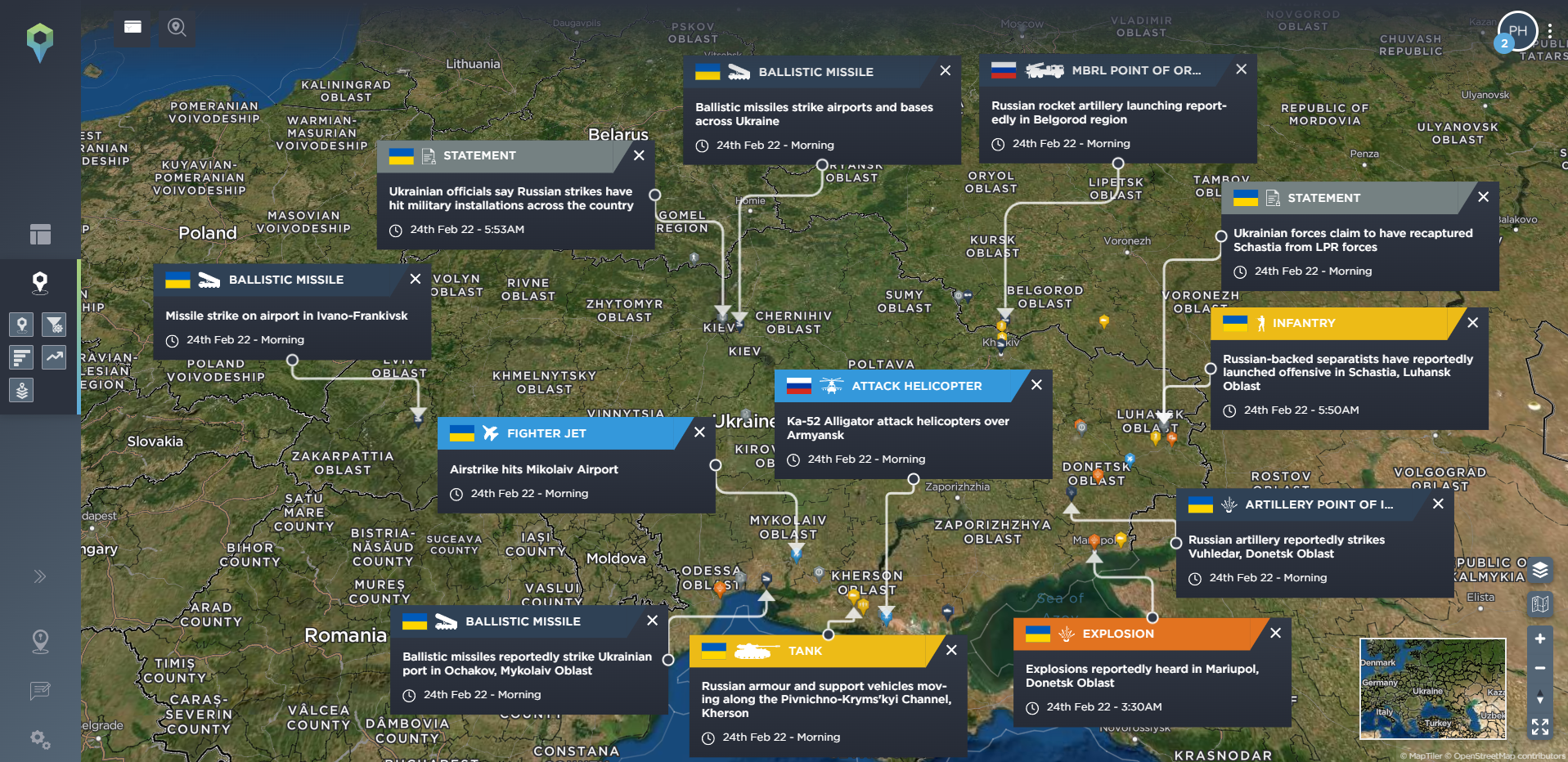
Over the last 24hrs, our monitoring has seen the intensification of fighting between Donetsk/Luhansk Separatists and Ukrainian forces in the Donbass region. Reports have indicated offensives and counter-offensives occurring along the Donbass frontlines. Elsewhere, Russia has begun attacking the whole of Ukraine with heavy artillery and ballistic/cruise missile attacks on all major airports and military bases; with ground forces from Russia, Belarus and Crimea entering Ukrainian territory.
Reports at this time continue to show attacks being carried out by Russia against Ukraine but little to indicate what ground has been taken/retaken. For the time being, it appears that fighting will remain at its most intense in the Donbass region with both sides employing all available means against each other. Across wider Ukraine, Russian ground forces will push towards major cities from Crimea, Russia and Belarus while heavy artillery and ballistic/cruise missile attacks continue across Ukraine.
25th February 2022
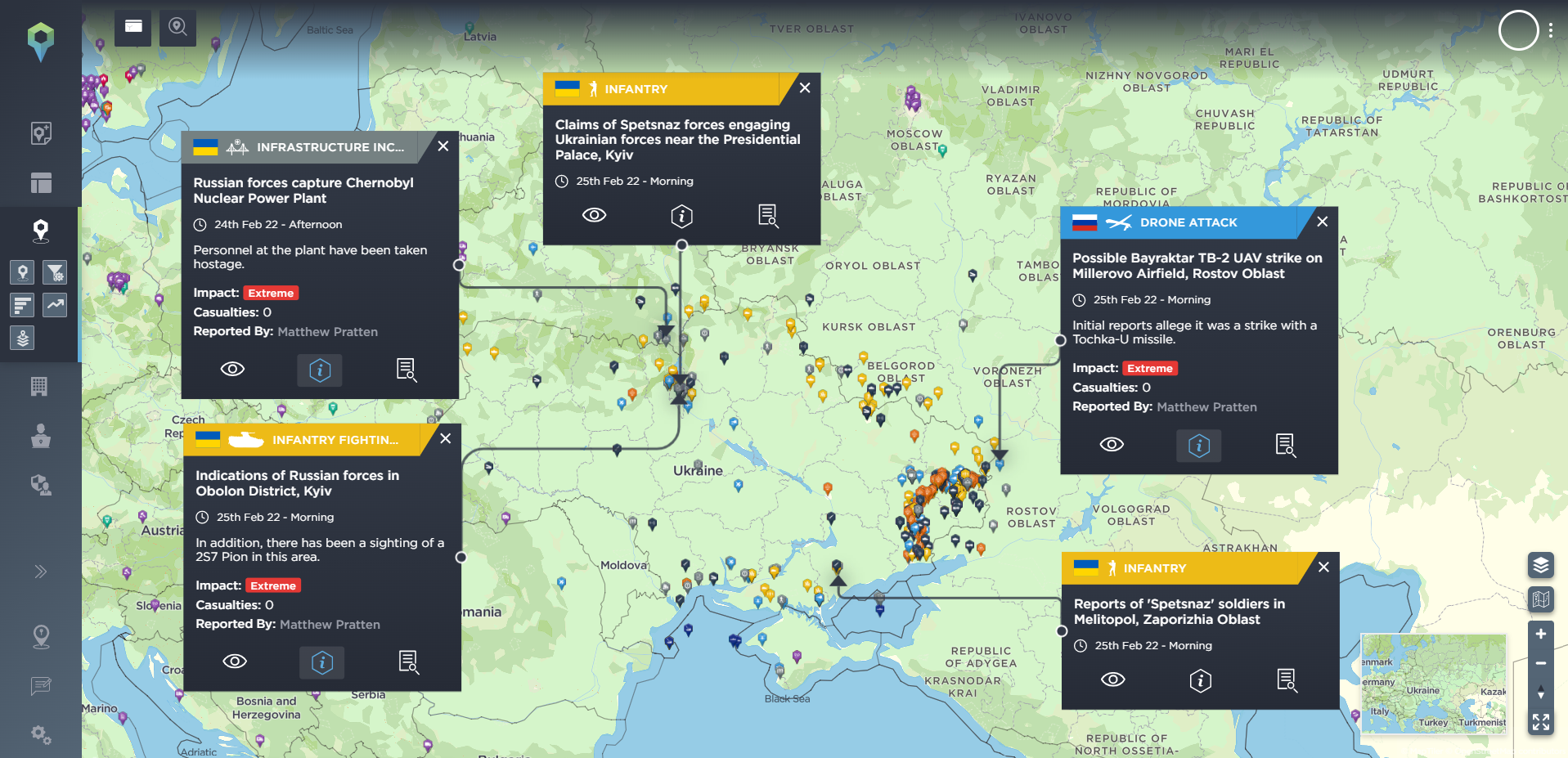
Russian forces have been able to take full control of areas along the Belarus and Russian borders (Sumy, Kherson and Chernihiv Oblasts) which includes the Chernobyl Nuclear Power Plant. Fighting in the Donbass region has remained intense. Elsewhere, there have been reports of Spetsnaz soldiers in Melitopol (Zaporizhia Oblast). Also, Ukrainian forces have allegedly carried out a drone/missile strike on a Russian Air Force base in Rostov Oblast.
However, the main issue remains Kyiv. Russian forces have been able to enter the city this morning, with heavy fighting reported in Obolon district. Reports have indicated the presence of heavy armour in this district and more armour from Belarus appears to be en route. Additionally, reports have indicated the presence of Spetsnaz forces fighting at the Presidential Palace in Kyiv and President Zelensky is – allegedly – ready to consider negotiations.
These reports indicate that despite losses on both sides, Russia’s invasion appears to be enjoying a great deal of success. Considering the above, it is probable the fighting will intensify further over the next 24hrs, with the possible capture/killing of President Zelensky or the commencement of negotiations which will be on Russia’s terms.
However, the intense fighting across Ukraine means this situation remains very fluid.
26th February 2022
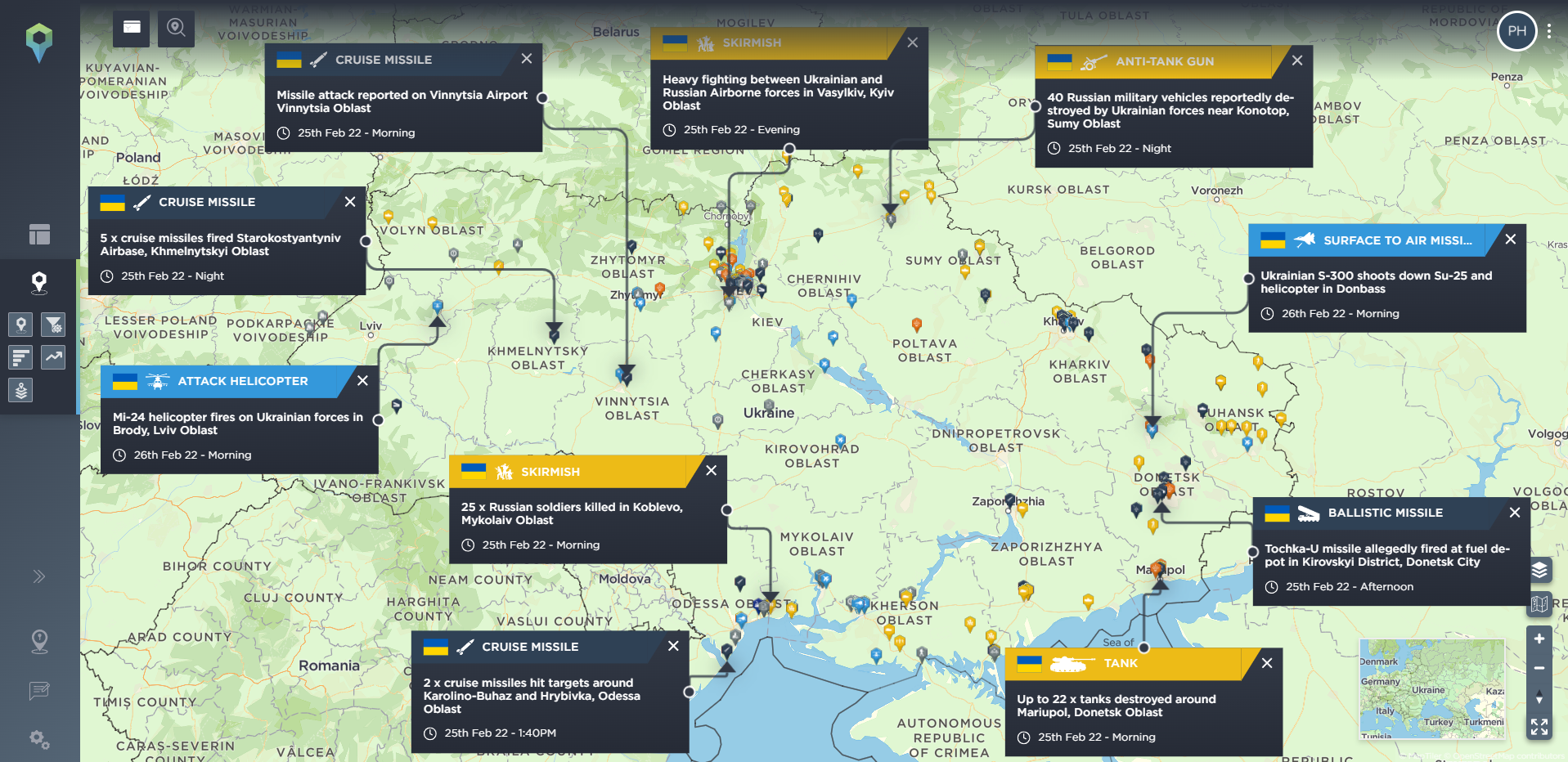
Over the last 24 hours, Ukrainian forces appear to be successfully defending Russia’s attacks; shooting down aircraft and repelling attempts to take Kyiv (the most successful defence so far appears to have been the defence of the Vasylkiv Airbase to the southwest).
Elsewhere, Russian forces appear to be having difficulty holding terrain they have seized in Kharkiv and Sumy Oblasts. Numerous reports have featured destroyed Russian artillery and tanks. There are indications that Russian logistics in these areas have found it difficult to resupply frontline forces who have consequently run out of fuel.
In Donbass, Ukrainian forces appear to have been firing Tochka-U missiles on fuel depots; with claims of collateral damage being made by separatists in these areas. This could be an indication of success given these forces have been making frequent, dubious claims of Ukraine committing atrocities.
However, Russia appears to have carried out several more ballistic/cruise missile strikes on airports and air bases across the country.
Overall, Russian Airborne and Ground Forces appear to be experiencing heavy losses when fighting Ukrainian troops in direct engagements. This may see Russia revert back to carrying out an overwhelming amount of missile strikes and indirect fire in order to recover from recent losses.
27th February 2022
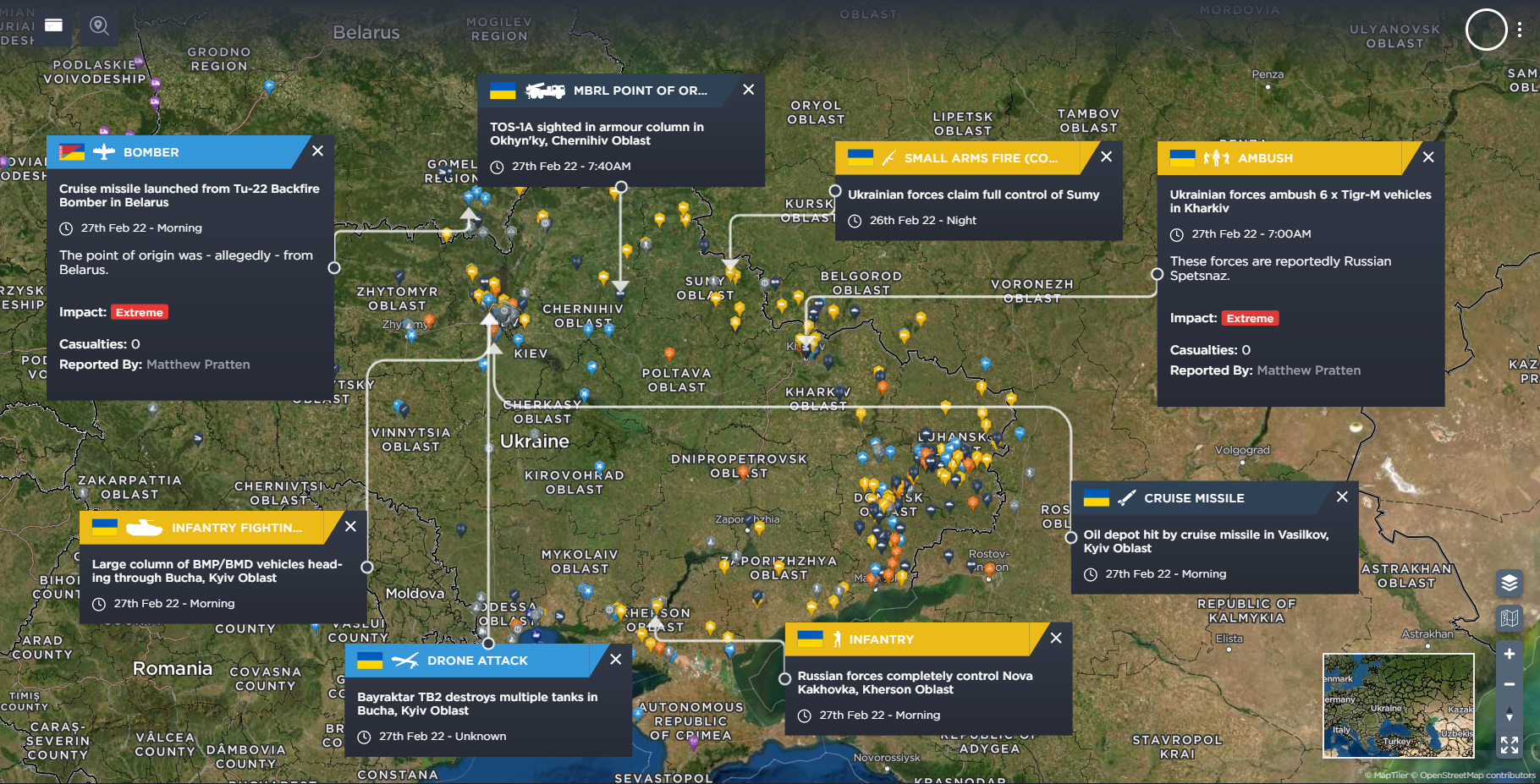
Russian efforts to take Kyiv continue to be repelled. Fighting has continued at the Hostomel airport and has resumed around Vasilkiv with at least two cruise missiles striking the area. Chechen fighters appear to have been brought in based on the reported death of General Magomed Tushayev in Hostomel. Additionally, Ukrainian Bayraktar TB2 drones appear to have inflicted losses on Russians in Bucha (and across the country).
Elsewhere, Ukrainian forces appear to have retaken parts of Sumy and Russian forces appear to be en-route to retake it. Heavy fighting is ongoing in Kharkiv between Ukrainian forces and alleged Spetsnaz elements.
Despite these successes, Russian forces have been making gains in the south, particularly in Kherson Oblast. Furthermore, Russia appears to be increasing its attacks with reports of a recent cruise missile being fired from a Tu-22 bomber flying in Belarusian airspace and sightings of TOS-1A rocket launcher systems in Chernihiv Oblast (between Sumy and Kyiv). Like the BM-21 BM-27 systems, this asset fires a large number of rockets to destroy area targets; however, it fires thermobaric rockets rather than high explosives.
Russian forces may begin to use more deadly, long-range weapons systems; leading to increased casualties on Ukrainian forces. TOS-1A artillery fire may see significant casualties on Ukrainians in Kyiv, Sumy or Kharkiv.
28th February 2022
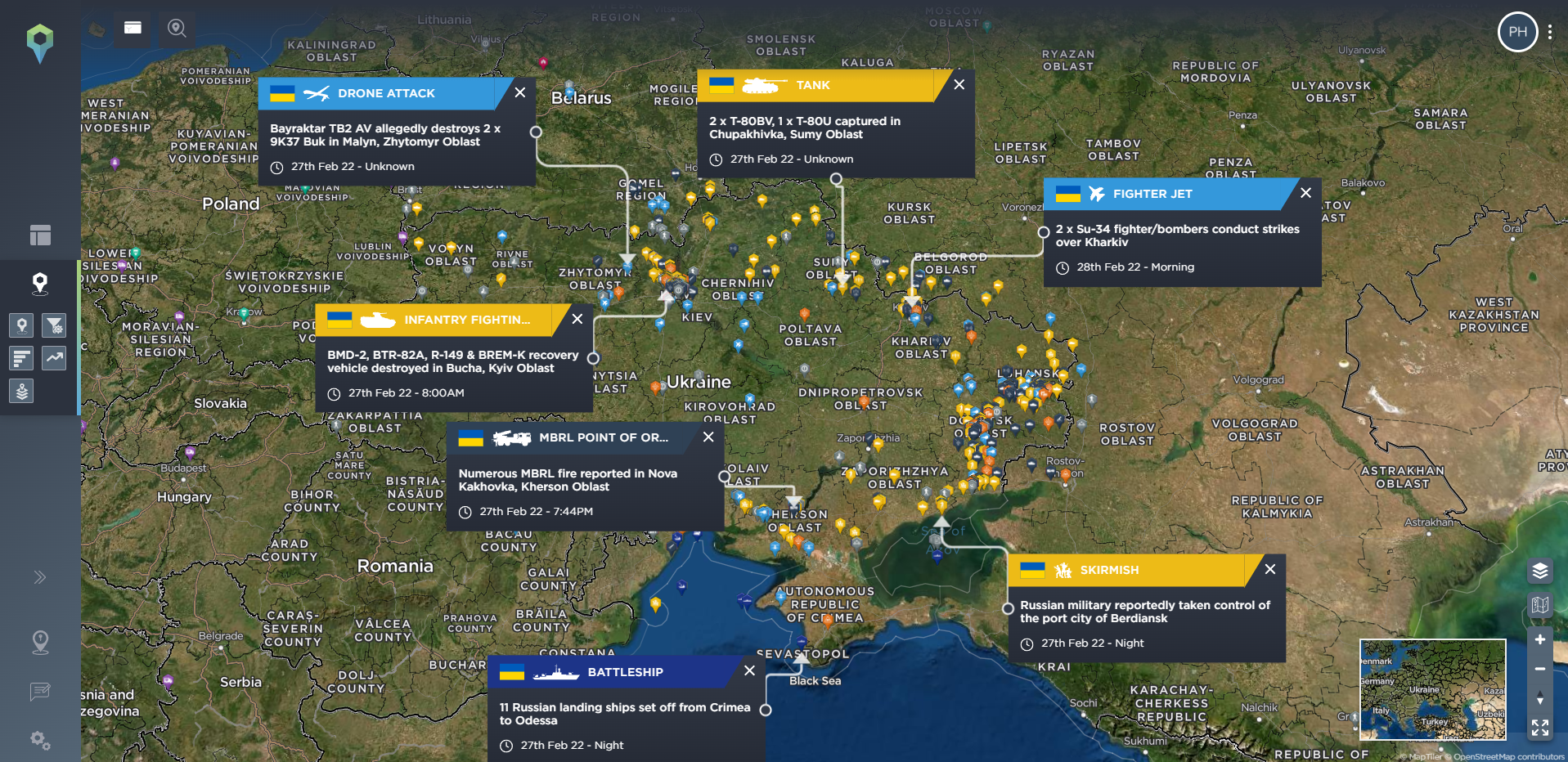
Russian efforts to take Kyiv continue to be repelled. Open-source reports continue to show success by Ukrainians in direct engagements with Russian forces; with numerous reports indicating Russian armour, anti-aircraft and artillery being destroyed or captured in Kyiv and in the north of Ukraine. In addition, Bayraktar TB2 drones have carried out successful attacks against Russian assets.
Despite these successes, the overall effect appears to be delaying the Russian advance. Russian Aerospace Forces have been carrying out multiple airstrikes on Kharkiv. Latest reports indicate Russian forces have continued to have successes in the south of Ukraine, the earliest being the seizure of the port town of Berdyansk. Furthermore, the capture of Nova Kakhovka in Kherson has now featured barrages of Multiple Barrel Rocket Launchers (MBRL) – possibly BM-21 Grad – being fired and indications of landing ships heading towards Odessa. There have been no further sightings of TOS-1A MBRL since the previous report. This could be deliberate given the recent successes of Bayraktar drone strikes.
At this time, it appears Russian forces have advantages in indirect strikes from artillery and air assets while in direct engagements, Ukrainians have successes in destroying or capturing Russian armour. This may see an increase in airstrikes and artillery fire occur over the next 24 hours by Russian forces.
1st March 2022 Prior analysis on Russian forces increasing the use of air and artillery assets appears to have been correct. There have been reports of Russian indirect strikes with a combination of rockets, artillery, airstrikes and ballistic missiles across Ukraine. The most recent attack has been the targeting of Svobody Square in Kharkiv. Video footage indicates several civilians were caught within the blast of what appears to have been an attack from a 9K720 Iskander /SS-26 Stone missile launcher. While their use hasn’t been confirmed, there has been at least one more sighting of a TOS-1A Multiple Rocket Launch System (MRLS) and a new weapon sighting – the Cheburashka, a 32-barrel MRLS – outside Mariupol. This city has been under sustained attack over the last 24-48 hours. Mariupol appears to be the last Ukrainian-held city on Ukraine’s southern coast. If lost, the entire south coast of Ukraine will be under Russian control. Nonetheless, Ukrainian forces continue to inflict heavy losses on Russian ground forces around Kyiv and major cities to the north; and reports indicate a significant amount of arms and aid is en-route from NATO members. However, Russian forces will likely increase their indirect attacks and airstrikes across Ukraine intended to inflict maximum damage and casualties to Ukrainian forces personnel and infrastructure; and the southern coast is likely to be under Russian control over the next 24-48 hours. 2nd March 2022 Artillery and missile attacks along with airstrikes have continued over the last 24 hours. Kharkiv continues to be hit with missiles, artillery, rockets and airstrikes; with reports of skirmishes in the wider Kharkiv region. The same appears to have been occurring in Zhytomyr and ground forces appear to be increasing to the north west of Kyiv. In the south, Mariupol continues to be surrounded. Latest reports indicate the power to the city has been cut. Elsewhere, there have been reports of Russian troop movements in Kherson, Mykolaiv and Zaporizhia. Coinciding with these developments have been reports of air raid sirens in the city of Dnipro. Additionally, there have been several reports of civilians in Russia-held areas of Ukraine carrying out street protests/roadblocks to hinder Russian troops. Reports have also suggested an increasing role of Belarusian forces along Ukraine’s border. This is being verified. While Ukrainians continue to inflict heavy losses and withstand the airstrikes and artillery, Russian forces appear to be encircling cities in the north; with the priority of surrounding Kyiv. In the south, Russian forces appear to be consolidating and beginning to advance north, with Dnipro appearing to be a target. With civilians resorting to roadblocks, there are increased chances of rioting and shootings as Russian forces will be eager to push north. 3rd March 2022 Widespread artillery, missile and airstrikes have continued over the last 24 hours; with indications of growing civilian casualties. Amongst the growing amount of collateral damage by Russian attacks appears to have been a member of the Organisation for Security and Cooperation in Europe (OSCE) in Kharkiv, numerous civilian casualties nationwide as well as attacks on infrastructure; oil depots, gas pipes, manufacturing plants, government buildings and train stations. While reports have indicated Ukrainian forces have been able to counterattack and retake parts of Kyiv’s western outskirts, reports of skirmishes around Kyiv suggest that Russian forces are slowly making progress in surrounding the city. Separate reporting has indicated a second round of negotiations between Russian and Ukrainian officials is being scheduled near the Polish border in Belarus. Current understanding of Russian military doctrine is that the use of force is for the purpose of creating widespread instability and destruction in order to influence the intended target – in this case the Ukrainian government – to agree to Russian terms for the cessation of hostilities. Until the next round of talks begin, it is likely the widespread use of artillery, missiles and airstrikes will continue in order to influence Ukraine to agree to Russian terms for the sake of ending the war. 4th March 2022 Over the last 24 hours, reports have indicated that the second round of negotiations have occurred between Russia and Ukraine in Belarus; with the outcome being the establishment of humanitarian corridors to allow women and children to leave. While this has happened, there have been reports of troop movements and skirmishes between Ukrainian and Russian forces on the outskirts of major cities – particularly Kyiv, Zhytomyr, Sumy and Kharkiv. In the south, Russian forces have taken full control of Kherson and the Zaporizhia Nuclear Power Plant in Energodar following clashes with civilians who have been blocking access. To the east, Mariupol remains completely encircled in a method of Russian warfare known as the ‘cauldron;’ where Russian forces completely surround a target and attack with an overwhelming amount of force as well as cutting access to supplies and power – essentially a contemporary version of siege warfare. From examining the troop movements, skirmishes and humanitarian corridors over the last 24 hours, it would appear that the very same is about to occur against Kyiv. Over the next 24-48 hours, Russian forces will likely begin to take major cities from the northeast and south and push towards Kyiv; surrounding it in all directions and carrying out a ‘cauldron’ strategy. Ukrainians will continue to inflict heavy casualties and likely resort to insurgency tactics, but Russian forces will begin to create conditions intended to force negotiations that would see Russia’s terms met. 5th March Reporting over the last 24 hours has indicated a gradual advance by Russian forces to encircle cities. Humanitarian corridors appear to be established but non-combatants appear to be at increased risk. An agreement to allow civilians to evacuate Mariupol has allegedly been set in place this morning but this does not automatically guarantee fighting will be paused. In the south and east, there are reports of civilians taking to the streets to protest against the Russian invasion, the latest being in Kherson which has now come under Russian control. Furthermore, reports have indicated efforts to sabotage Russian advances and indications of foreign fighters on both sides; there have been at least two incidents of rail bridges being destroyed. Latest reports have made claims of Georgian National Legion members fighting alongside Ukrainians and ‘ISIS Hunters’ trained by Wagner group fighting alongside separatists. In addition, reports from this morning claim that Russian forces are now advancing towards the South Ukraine Nuclear Power Plant in Yuzhnoukrainsk. Despite the humanitarian corridors, Russian forces continue their efforts to encircle major cities in order to eventually encircle Kyiv and appear to be having success in doing so; albeit gradually. With reports of destruction of infrastructure and indications of foreign fighters, the war in Ukraine appears to be showing signs of an insurgency developing. 6th March 2022 Russian air, missile and artillery strikes appear to have resumed across the country over the last 24 hours; with Kyiv, Zhytomyr and Kharkiv Oblasts being the focus. The resumption of these strikes appears to have caused an increase in civilian casualties who were trying to reach evacuation points. Significant incidents in the last 24 hours, as of the 6th March 2022 Among the most significant incidents were a mortar attack on civilians crossing a bridge in Irpin (Kyiv Oblast) and a building collapsing on up to 200 civilians in Mariupol (Donetsk Oblast) which continues to be surrounded. In addition, reports have indicated that Russian forces have placed armour and surface-to-air missile systems among urban areas in Sumy Oblast, likely to avoid being targeted by Ukrainians without causing civilian casualties. Elsewhere, fighting has continued in the Donbass region with the majority of incidents being mortars, artillery and cruise missile attacks. Additionally, Ukraine’s security service has reported the discovery of a network of agitators in the West of the country trying to set up ‘People’s Republics’ similar to those which began the war in Donetsk and Luhansk Oblasts in 2014. This resumption of intense air, missile and artillery strikes appears to be intended to increase pressure on Ukraine prior to the upcoming third round of negotiations. Russian forces appear to be increasing the amount of damage around Ukraine as per its doctrinal purpose of military force: to create widespread chaos and instability in order to pressure the cessation of hostilities on Russian terms. With civilians trying to reach evacuation points and Russian placement of assets among urban areas, the amount of civilian casualties is set to increase significantly alongside an already significant amount of damage to major cities and infrastructure. 9th March 2022 Russian forces have continued to attack major cities with airstrikes and indirect fire causing significant collateral damage in terms of civilian casualties and infrastructure regardless of humanitarian corridors. Recent reports have suggested Russian forces have been pushing civilians towards Russia/Belarus and placing weaponry among civilian areas. Significant incidents in Ukraine between the 6th and 9th March 2022 Kyiv is becoming increasingly surrounded by Russian forces despite Ukraine continuing to inflict heavy losses on Russia. Despite controlling the south and east, Ukrainians are continuing to protest against Russian forces and there have been indications that a push to take Odessa is beginning. These could be possible due to Russian forces now trying to push north to take Dnipropetrovsk, Poltava and Kirovohrad Oblasts which will further encircle Kyiv (and all key infrastructure along the way). Central and Western Ukraine appear largely unaffected by Russian attacks at this time but are the focus for Russian intelligence operations trying to create social unrest and are experiencing significant issues with Ukrainians fleeing from Kyiv, Southern and Eastern Ukraine. Overall, regardless of their losses, Russian forces appear to be fulfilling their larger aim in causing significant chaos, destruction and unrest to pressure an eventual cessation of hostilities on Russia’s terms. Despite continuing to inflict heavy losses on Russian forces, Ukrainian cities are becoming encircled and will eventually be subject to sieges which will see an increase in air, artillery, rocket and missile strikes. Considering Russian military doctrine being a means to achieve a Russian political end through causing chaos, destruction and unrest to pressure an adversary to sue for peace at any cost, Russian forces are fulfilling their intended role and will likely increase the intensity and tempo of their attacks until another round of talks occurs between Russian and Ukrainian delegations. These attacks will likely become increasingly indiscriminate; causing significant casualties and the placement of weapons in civilian areas will also have increased collateral damage from Ukrainian counter-attacks. 16th March 2022 Russian aircraft activity appears to have increased across the country. While this activity has added to ongoing indirect fire attacks against major cities (Kyiv, Kharkiv and Mariupol especially), there has been a focus by Russian Aerospace Forces to target western and central Ukraine. These attacks have caused significant casualties, infrastructure damage and have raised concerns for escalation due to the proximity to the Polish border; further reporting on the airstrike in Yavoriv indicates a Russian drone patrolling the area had allegedly crossed into Polish airspace. Statistics for the incidents reported by Intelligence Fusion in Ukraine between the 9th and 16th March 2022. Coinciding with these airstrikes and indirect fire, Russian forces appear to have been cutting/damaging critical infrastructure based on reports across Ukraine of gas, electricity and water being cut. Considering the weather conditions, cutting access to heat, electricity and water will exacerbate poor living conditions and affect the Ukrainian will to fight. In the south, Russian forces now appear to be responding to ongoing anti-Russian protests by focussing on kidnapping/arresting Ukrainian officials and crushing dissent among the local population. They are also continuing to advance north towards central Ukraine to add to the recent airstrikes. Additionally, the Russian Navy appears to be making another effort to take Odessa with numerous troop ships proceeding towards the coast and cruise missile/maritime attacks. Ukrainian forces continue to inflict heavy losses but nonetheless, Russian forces are continuing their advances to encircle major cities. With their targeting of critical infrastructure, many Ukrainians will soon find themselves in a position where they have no access to heat, electricity or water while being hit by artillery and bombed from the air. It is likely this situation will begin to break the Ukrainians’ will to fight, resulting in Russian ground forces beginning to gain an advantage and successfully surround major cities (Kyiv especially). If successful, Russia will soon be in a position where their demands of Ukraine will become acceptable due to a desire from Ukrainians to simply end the fighting. With the above occurring, calls for a no-fly zone and anti-Russia sentiment will grow. A NATO imposed no-fly zone will likely escalate the current war and lead to several unintended consequences; such as airstrikes on both sides of the Belarus-Russia-Ukraine borders. 23rd March 2022 At the time of this report, talks between Russian and Ukrainian delegations have continued but show little sign of significant progress. Fighting has continued with the tempo of incidents over the last seven days staying at the same high level since last week. What appears to have changed is a slightly higher use of indirect weapons (artillery, mortars, rockets and missiles) over direct engagements and airstrikes by Russian forces. These attacks have been concentrated on Kyiv, the south and east of the country; stretching from Odessa to Kharkiv Oblasts. Many of these incidents have included collateral damage. Nonetheless, Ukrainian forces appear to be maintaining their defences against Russian forces. Significant incidents in Ukraine between the 16th and 23rd March 2022 Among the indirect attacks have been two cases of Russians using their Kh-47M2 Khinzal (“Dagger”) hypersonic missiles. These attacks saw successful strikes on Ukrainian fuel and ammunition locations. These attacks have been a focal point of international attention as an indicator of Russia escalating the conflict. What does not appear to have been easily noticed is during these attacks with Khinzal missiles, Russian forces in Donetsk Oblast allegedly fired thermobaric rounds from a TOS-1A on Mariupol and white phosphorus munitions on Kramatorsk. While hypersonic missiles guarantee success on hitting targets, thermobaric and white phosphorus munitions easily exacerbate an already high amount of civilian casualties and damage to infrastructure; adding pressure on Ukraine to agree to Russia’s terms. Given previous reports showing Ukrainian superiority in direct engagements and Russian advantages with artillery and air strikes, Russian forces are likely to continue their focus on using artillery, missiles, rockets, mortars and air strikes in order to prevent further losses, destroy Ukrainian defences and pressure Ukraine to settle on Russia’s terms during diplomatic talks. During these indirect weapons attacks, Russia will be seeking to carry out further strikes with its Khinzal hypersonic missiles for three assessed objectives: Further use of Khinzal missiles could be a potential indicator for more severe attacks elsewhere. 30th March 2022 Significant incidents in Ukraine from 24th-30th March 2022 Russian forces appear to have relied on indirect weapons even more than in previous weeks; focussing on Kyiv and major cities across Ukraine’s borders with Russia and Belarus along with ongoing fighting in the east and south. They appear to be trying to fix Ukrainian forces with artillery and rocket attacks while attacking infrastructure with cruise and ballistic missiles. The missile attacks appear to have successfully hit oil and gas depots and government buildings. Additionally, new weapon systems appear to have been brought in along with white phosphorus and thermobaric munitions being used in the Donbass region. This increase in indirect attacks could be explained by reports of Ukrainian successes. With the exception of Mariupol, Ukrainian forces have been able to counter-attack recently, pushing back Russian forces surrounding Kyiv especially, destroying a troop ship in Berdyansk and killing senior Russian officers. If the claims of partial withdrawals, shifting focus to the Donbass region and alleged intercepts of conversations between Russian officers in Sumy Oblast are credible, Russian forces could be becoming desperate to stop Ukrainians from gaining an advantage. Although, Russian forces could be trying an alternative to realising prior assessed courses of action. While talks are occurring in Istanbul, the chances of the war in Ukraine ending soon are low. Russia will likely be keen to avoid further losses and prevent Ukrainian counter-attacks which may see a further increase in artillery, rocket and missile attacks across Ukraine’s northern cities. Along with causing more collateral damage to Ukraine’s infrastructure and greater civilian casualties, these tactics may also allow for Russian forces to pull back, consolidate and focus their attacks in the Donbass region where they still have a considerable advantage. With their forces in the East, Russia could attack from within and outside the country, then attempt to take central Ukraine in order to end the conflict on their terms.
6th April 2022 Ukrainian forces have continued to counterattack and have regained control of the majority of areas surrounding Kyiv, the Chernobyl Nuclear Power Plant and Chernihiv. With these successes have come revelations of mass executions, torture chambers and other war crimes; the discoveries in Bucha have caught considerable attention but there are indications of even worse incidents occurring in Borodyanka (further west of Bucha). Additionally, Russian forces appear to have mined or destroyed critical infrastructure prior to their withdrawals from Kyiv. This tactic has also been appearing across the country. Significant incidents in Ukraine between 31st March and 6th April 2022 Elsewhere, Russian forces have continued to carry out attacks with indirect fire weapons and missiles. They have increased their focus on Eastern and Southern Ukraine with a considerable amount of artillery, mortar, rocket and missile attacks (possibly using white phosphorus, thermobaric rounds and cluster munitions). These attacks have featured more reports of civilian casualties and collateral damage; including a tank of nitric acid being destroyed in Rubizhne resulting in an increased threat of dangerous chemicals to civilians and a civilian oil tanker being sunk in the port of Mariupol (which continues to be under siege). Ukrainian forces continue to defend their positions and have reportedly been able to use a captured TOS-1A ‘SoIntsepek’ thermobaric multiple barrel rocket launcher against Russian forces. Overall, Ukrainians have been able to capitalise on Russian withdrawals but now face considerable challenges in addressing potential war crimes and threats of damaged/sabotaged infrastructure while Russian forces concentrate their efforts in the East and South. With a round of conscription underway in Russia and forces being withdrawn from Kyiv and likely redeployed, Russian forces in Eastern and Southern Ukraine will soon have greater numbers and firepower at their disposal while Ukrainians clear up Kyiv and its surroundings. The reports of Russian war crimes across Kyiv appear to have credibility at this time. Of great concern is how close these alleged mass murder incidents were to Kyiv. With suggestions that worse acts have been carried out in Borodyanka, more remote areas of Ukraine (such as Mariupol and Kharkiv) could have featured even greater atrocities. If true, the fighting will intensify with Ukrainians being willing to carry out similar acts for revenge, which will increase pressure for international intervention and thus, increase the potential for the war to escalate; possibly stretching beyond Ukraine’s borders. 13th April 2022 Open-source reports continued to reveal the scale of atrocities committed to the West of Kyiv; with reports of mass graves in Makariv and Buzova, gang rape in Bucha and additional torture chambers Borodyanka. Further revelations of such activities are to be expected as Kyiv and Northern Ukraine are secured. Significant incidents across Ukraine between the 6th and 13th April 2022. While there have been significantly fewer direct attacks and airstrikes, indirect fire attacks have continued across Eastern and Southern Ukraine. Russian forces are keeping Ukrainians fixed in their positions while they redeploy troops to Eastern Ukraine and – as shown by the attacks in Barvinkove and Kramatorsk Station – are keen to prevent any Ukrainian reinforcements east even if that means potential mass-casualty attacks on civilians. With the redeployment of Russian forces to the Donbass region, it appears to be a matter of days until Mariupol is taken. Reports indicate that Ukrainian Marines and Azov Battalion forces have prepared a last stand at the Azovstal Industrial complex. Reports of chemical weapons remain inconclusive and may be the last attempt by Ukrainians to get support, but Russian forces have been willing to use phosphorus and thermobaric munitions in Mariupol (and elsewhere in the Donbass region). Russian forces may have withdrawn from Kyiv and its surrounds but are redeploying for a major offensive from the Donbass region which has the potential to push into central Ukraine; right up to the Dnieper River if successful. Russian forces and their separatist proxies will need to consolidate their positions first which will mean taking complete control of Mariupol while preventing Ukrainian forces from repositioning and reinforcing. Over the next seven days, an attack to wipe out Ukrainian forces at the Azovstal facility in Mariupol is probable and more indirect attacks on infrastructure (rail especially) are likely until Mariupol falls; which could potentially see more mass casualty incidents similar to the attack at Kramatorsk. Overall, fighting is about to intensify across the Donbass region. 20th April 2022 The Russian preference for indirect fire (mortars, artillery, rockets and missiles) has continued as per previous reports over the last week. The majority of these attacks have occurred across Kharkiv, Luhansk and Donetsk Oblasts. Significant activity reported between the 13th and 20th April 2022, regarding the Ukraine-Russia war. Ukrainian forces have been able to fortify the Azovstal facility for the last stand and so far it appears to have been successful in defending against direct attacks. However, an attempt by Ukraine’s 36th Marine Brigade to break through the siege appears to have failed with a number killed or captured. This situation has now seen Russian forces employing Tupolev strategic bombers on the facility. Russian forces now appear intent on completely destroying Azovstal and anyone remaining within it. While most activity has been concentrated in eastern Ukraine, there have been occasional – but effective – attacks elsewhere; missile attacks have been able to cause significant damage in Lviv and hinder clean-up and investigation efforts into alleged Russian war crimes (evidence continues to indicate these allegations are credible and widespread). Also of note is the recent ‘vote’ in Rozivka, Zaporizhia Oblast. Donetsk Separatists have reportedly overseen a vote for the town to join with the Donetsk People’s Republic. This is despite the town being outside the regional boundaries of Donetsk. A new Russian offensive has begun and for the time being, Mariupol, Lysychansk and Severodonetsk appear to be the priorities (in that order). It’s probable they will prioritise destroying forces barricaded in the Azovstal facility as soon as possible to consolidate all Russian-held territory. The Azovstal facility will probably be subject to intense and sustained bombing as the main effort for this objective. Other locations will likely be attacked to hold Ukrainian forces in their current positions until Mariupol is under complete Russian control. Once complete, Russian forces and their separatist proxies will likely proceed to capture all of Donetsk and Luhansk Oblasts which can then enable a return to Kharkiv and Kherson Oblasts as well as advances into Zaporizhia, Dnipropetrovsk and Poltava Oblasts. Capturing of Donetsk and Luhansk Oblasts will probably be claimed as liberation while further advances will likely see votes similar to Razivka occur to provide a veil of legitimacy.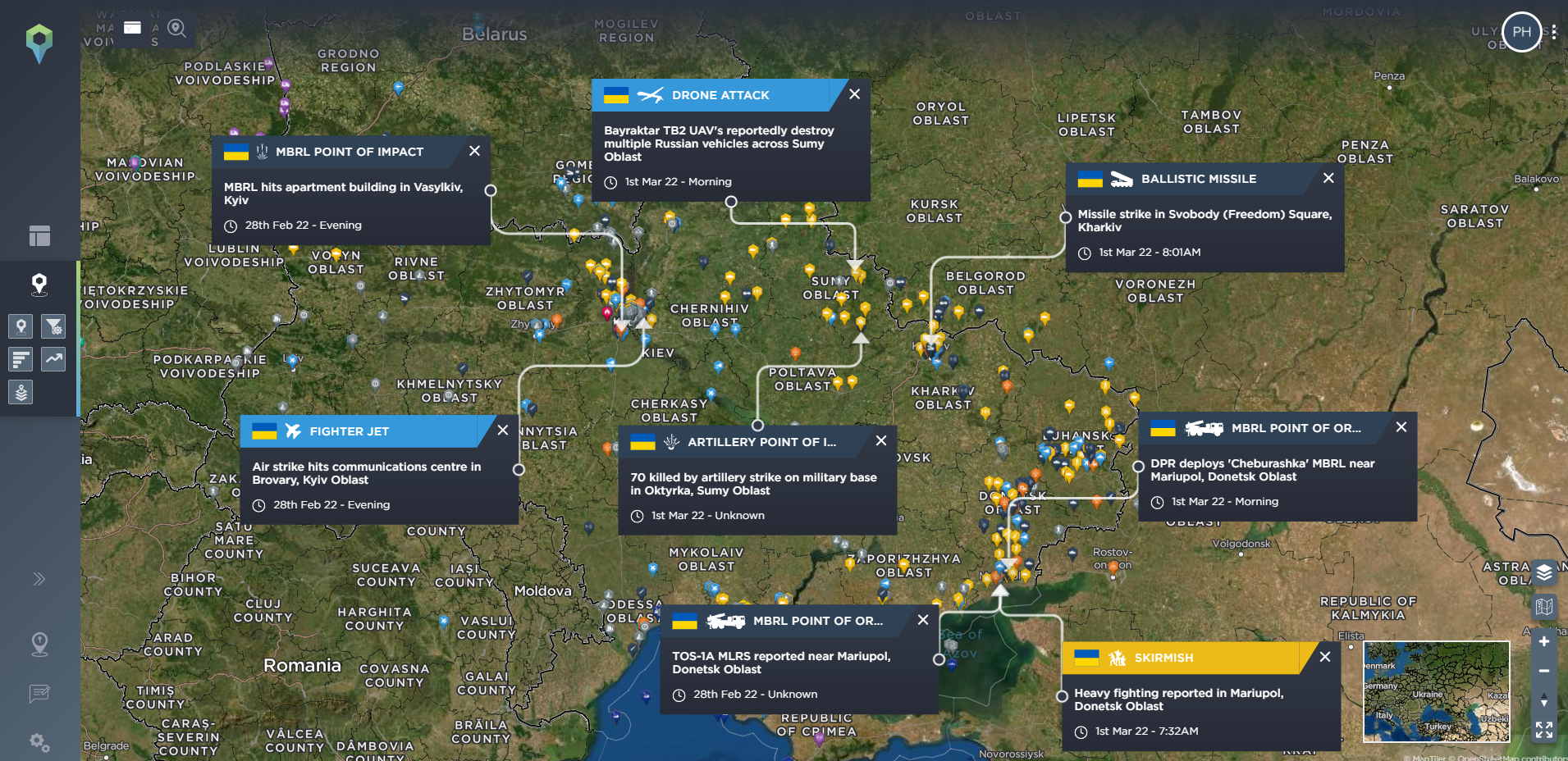
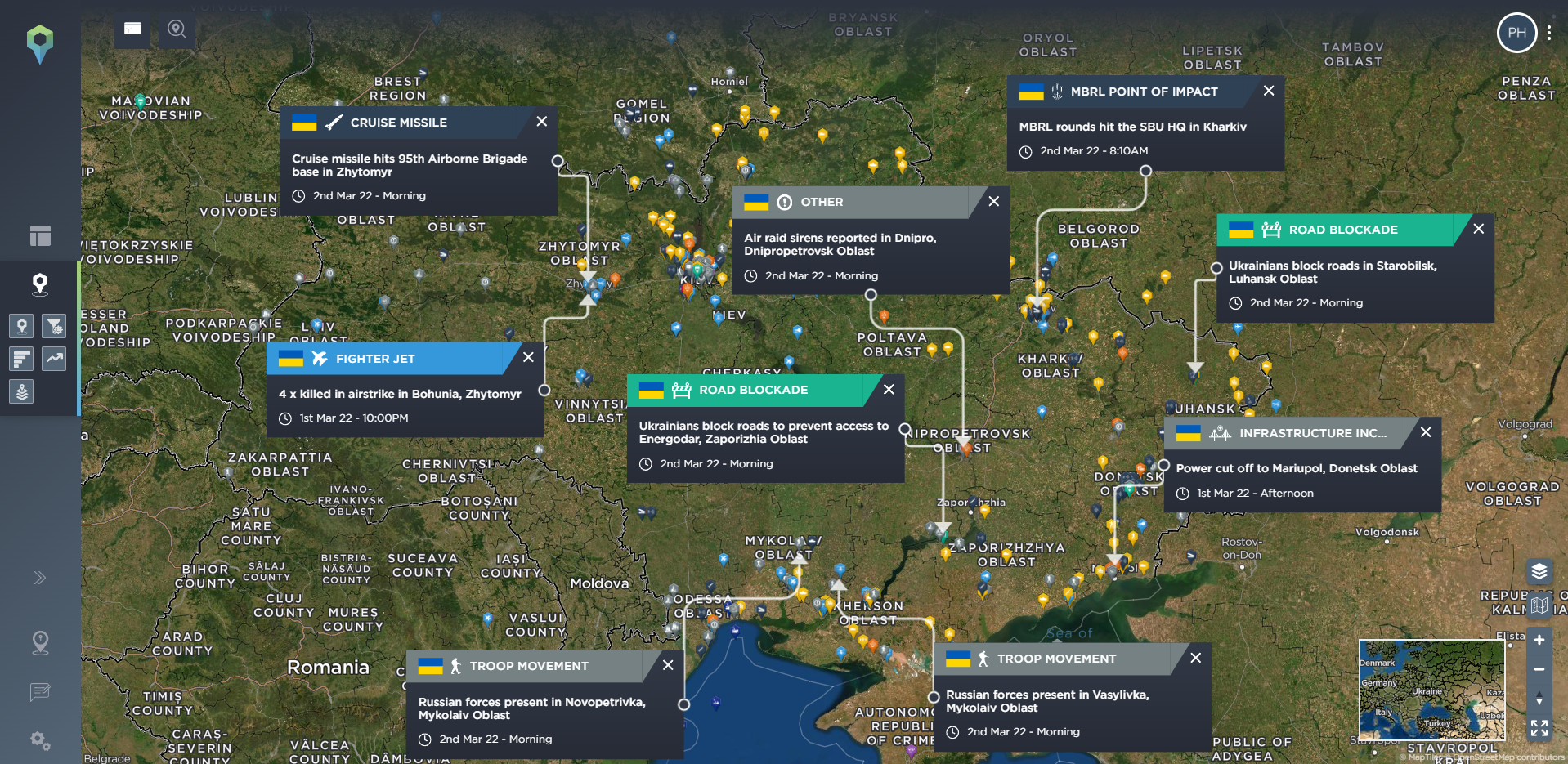
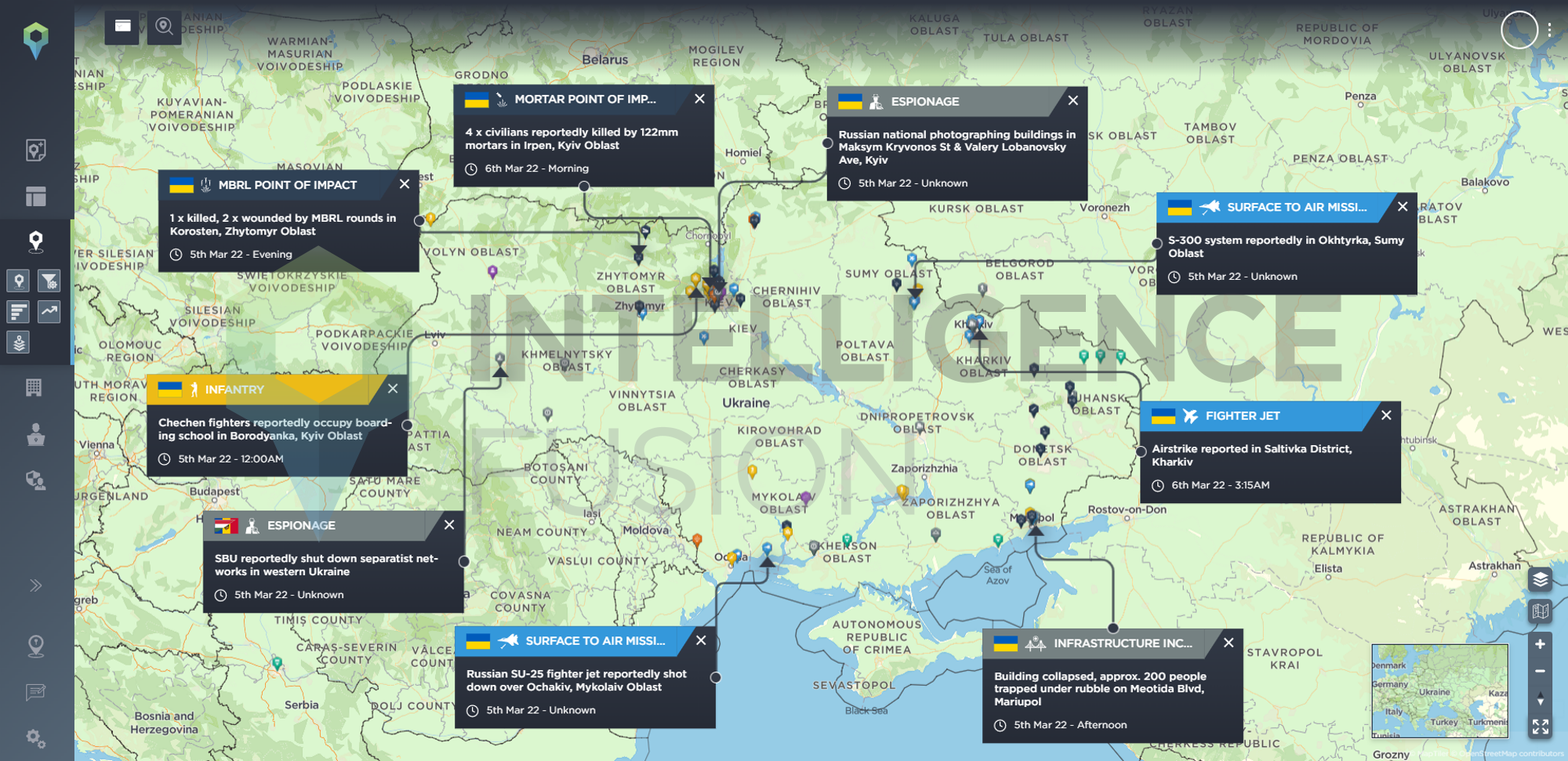
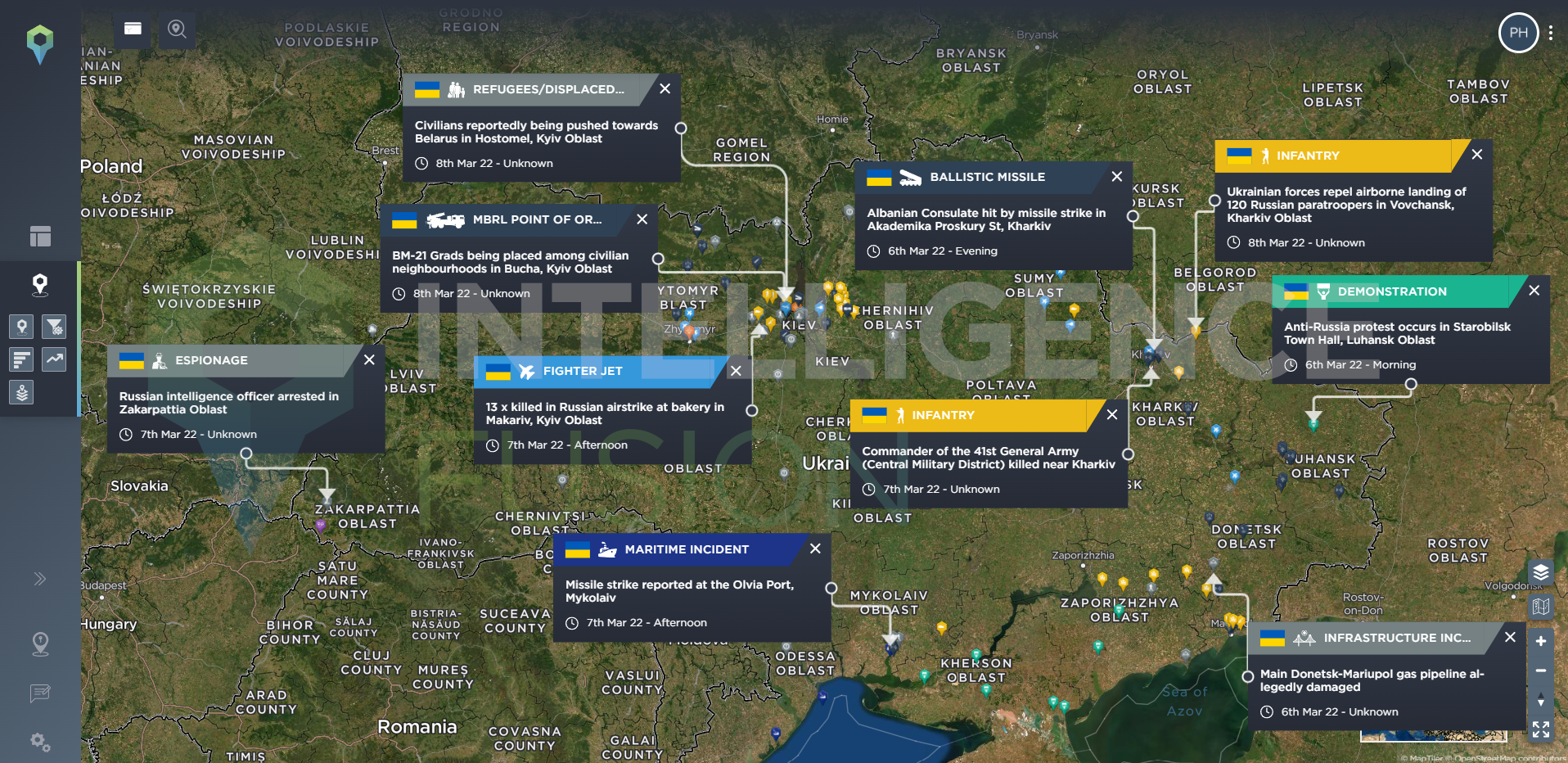
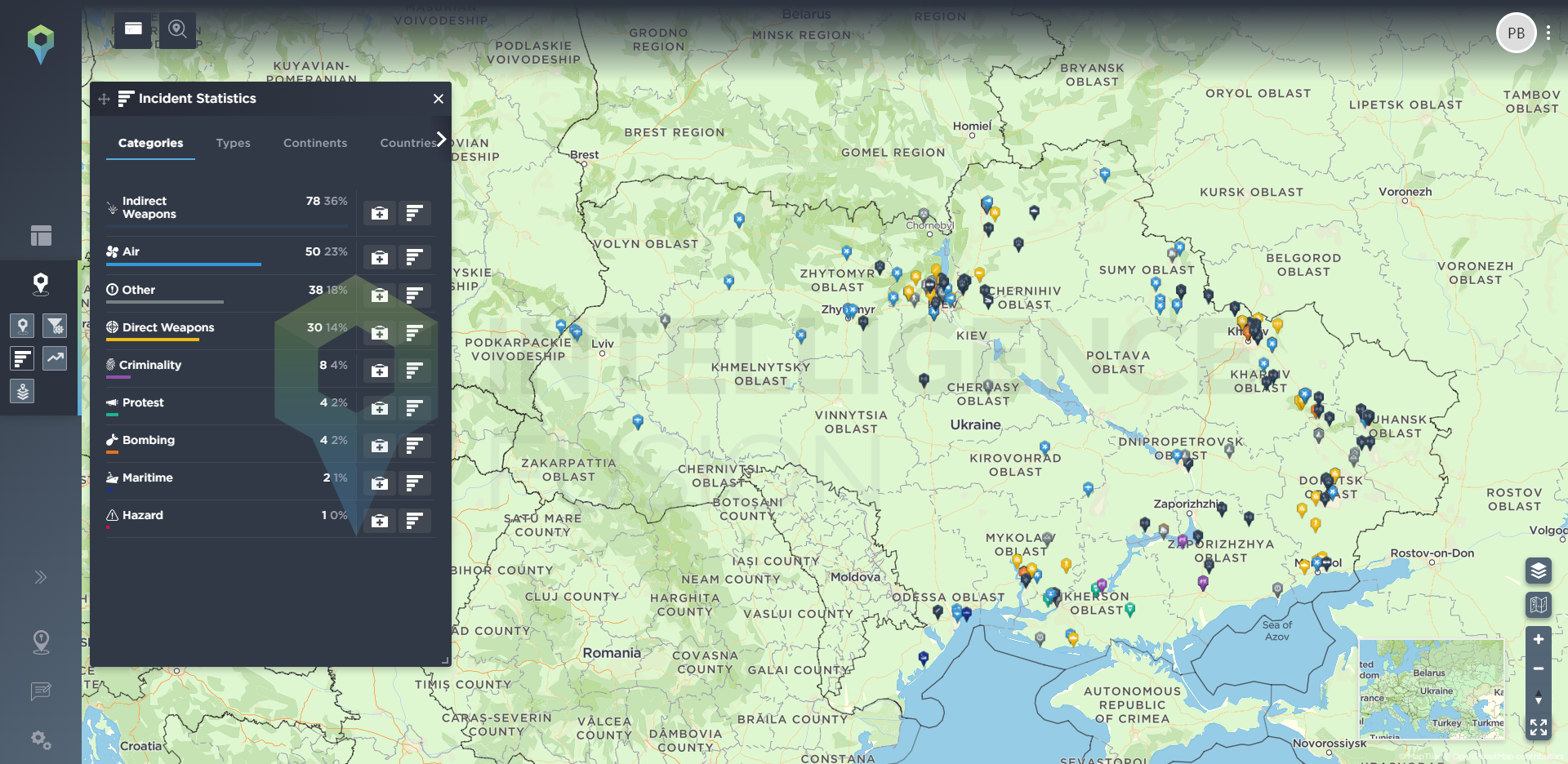
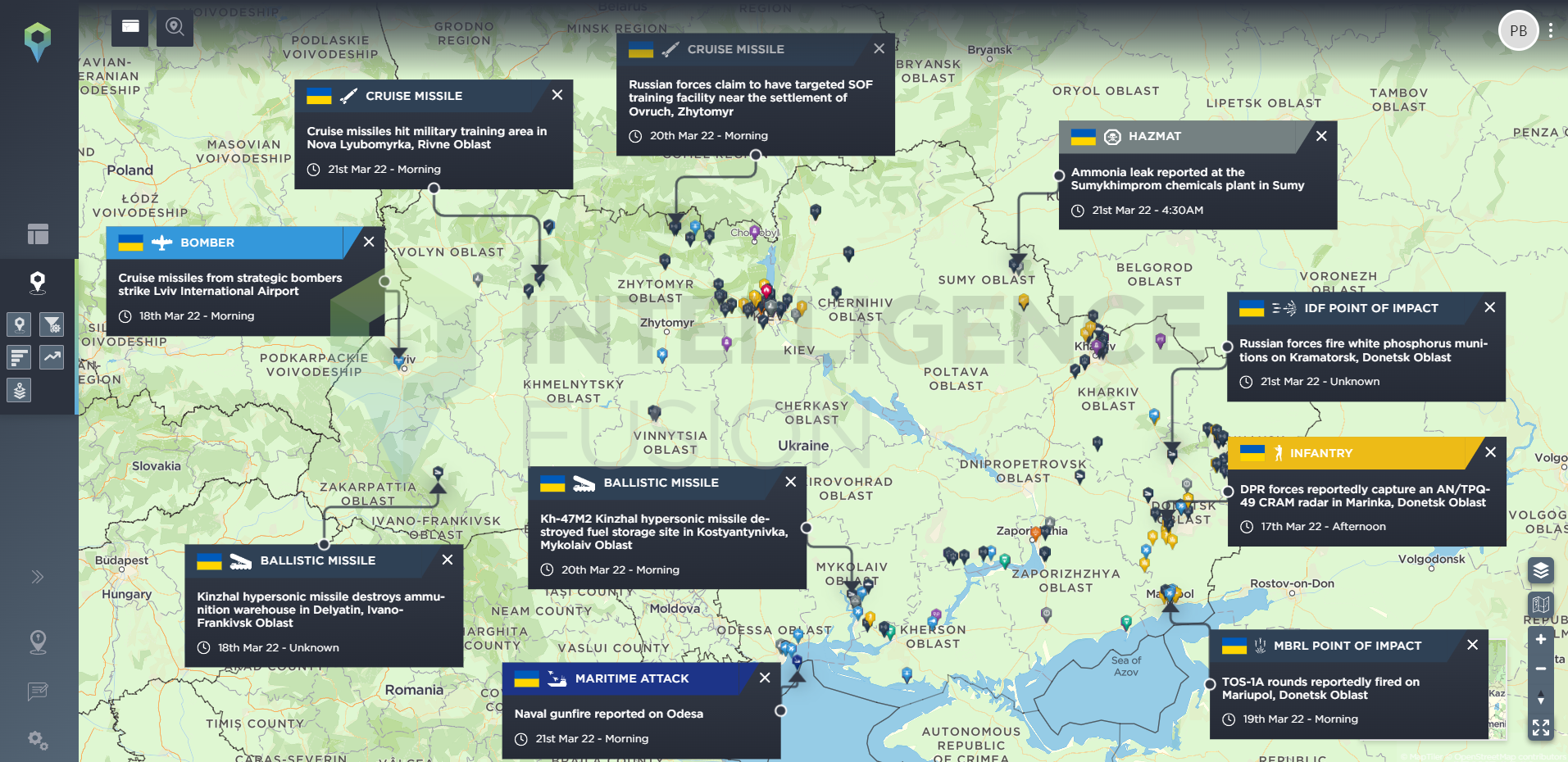
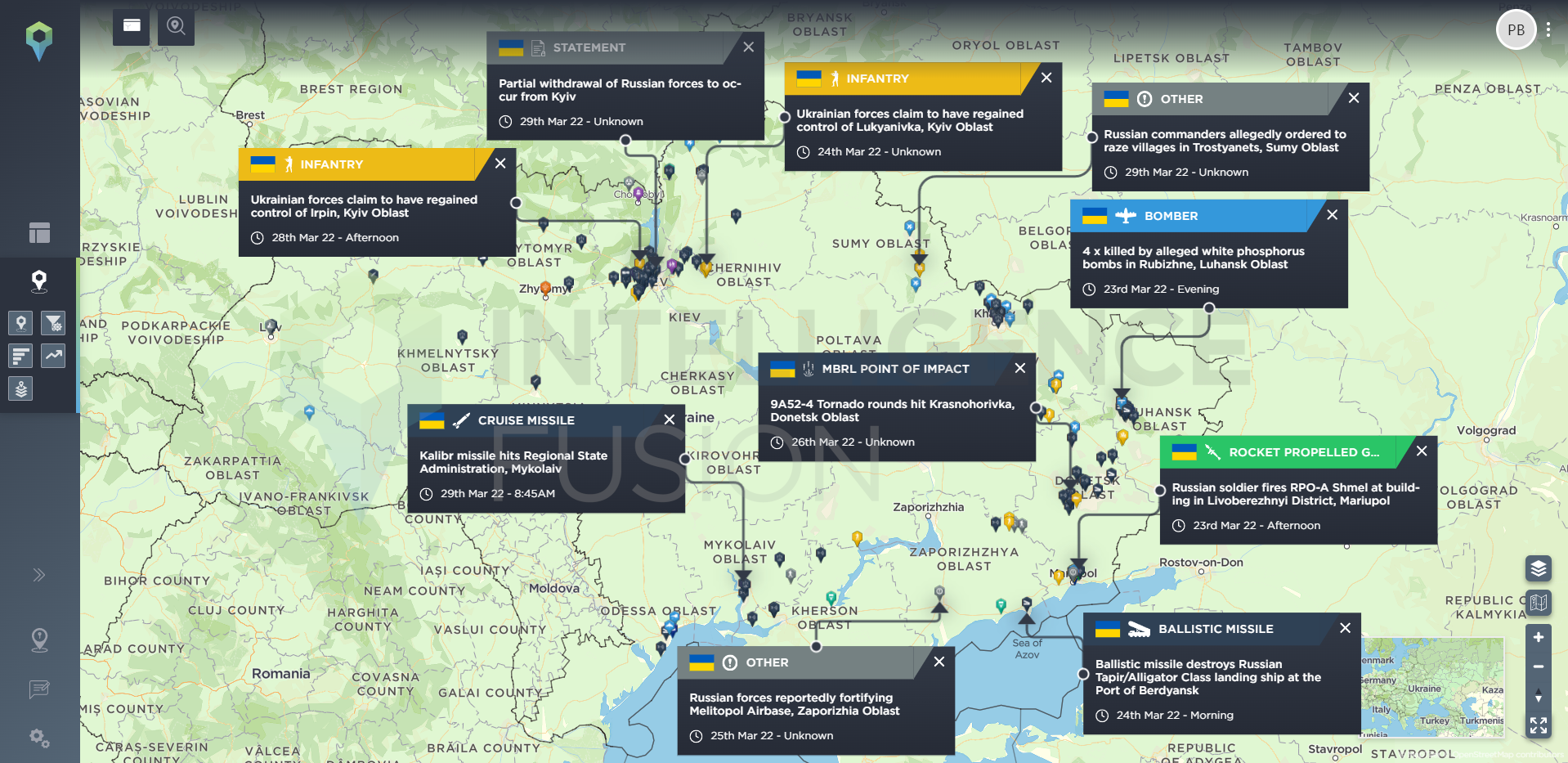
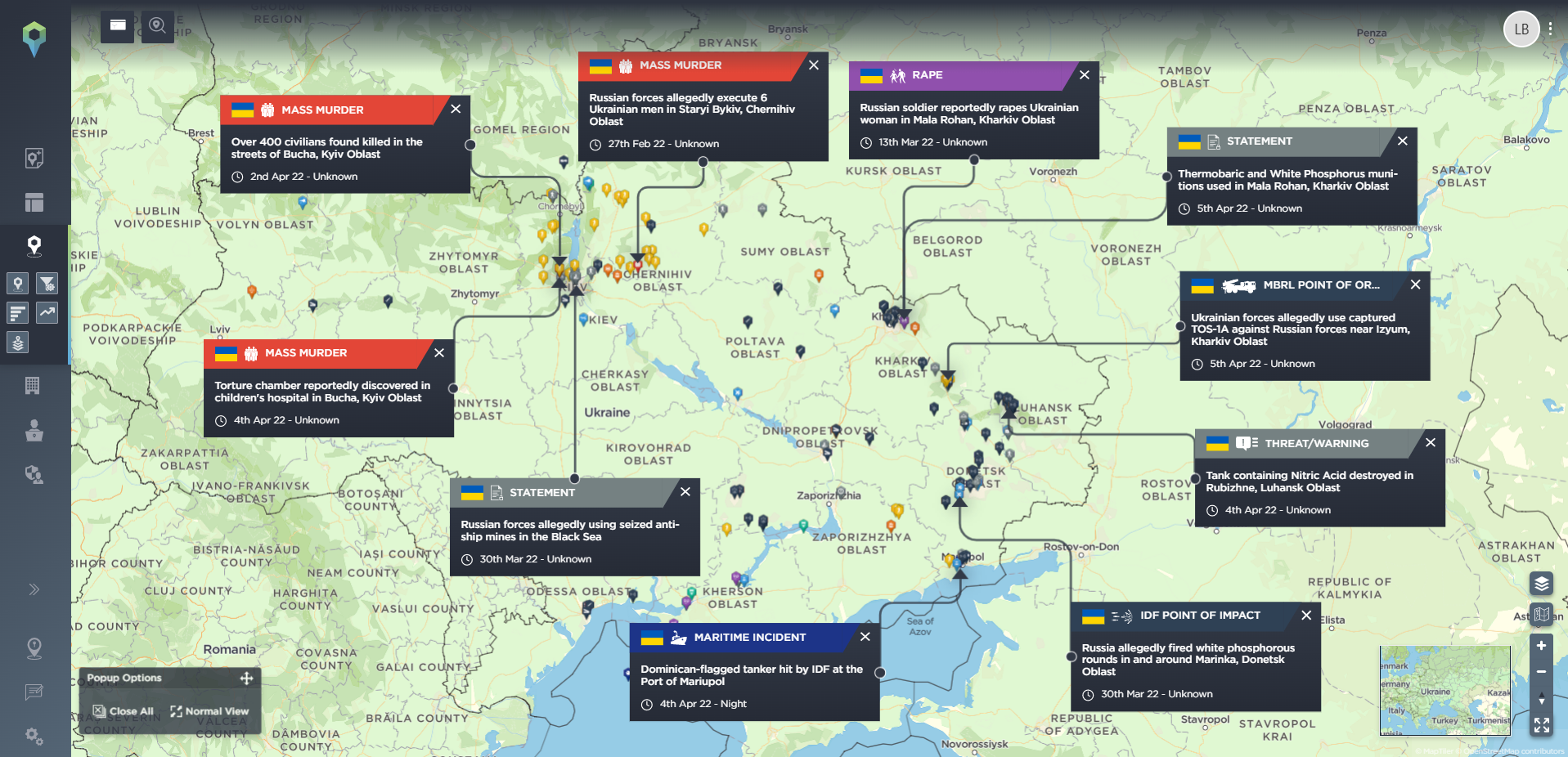

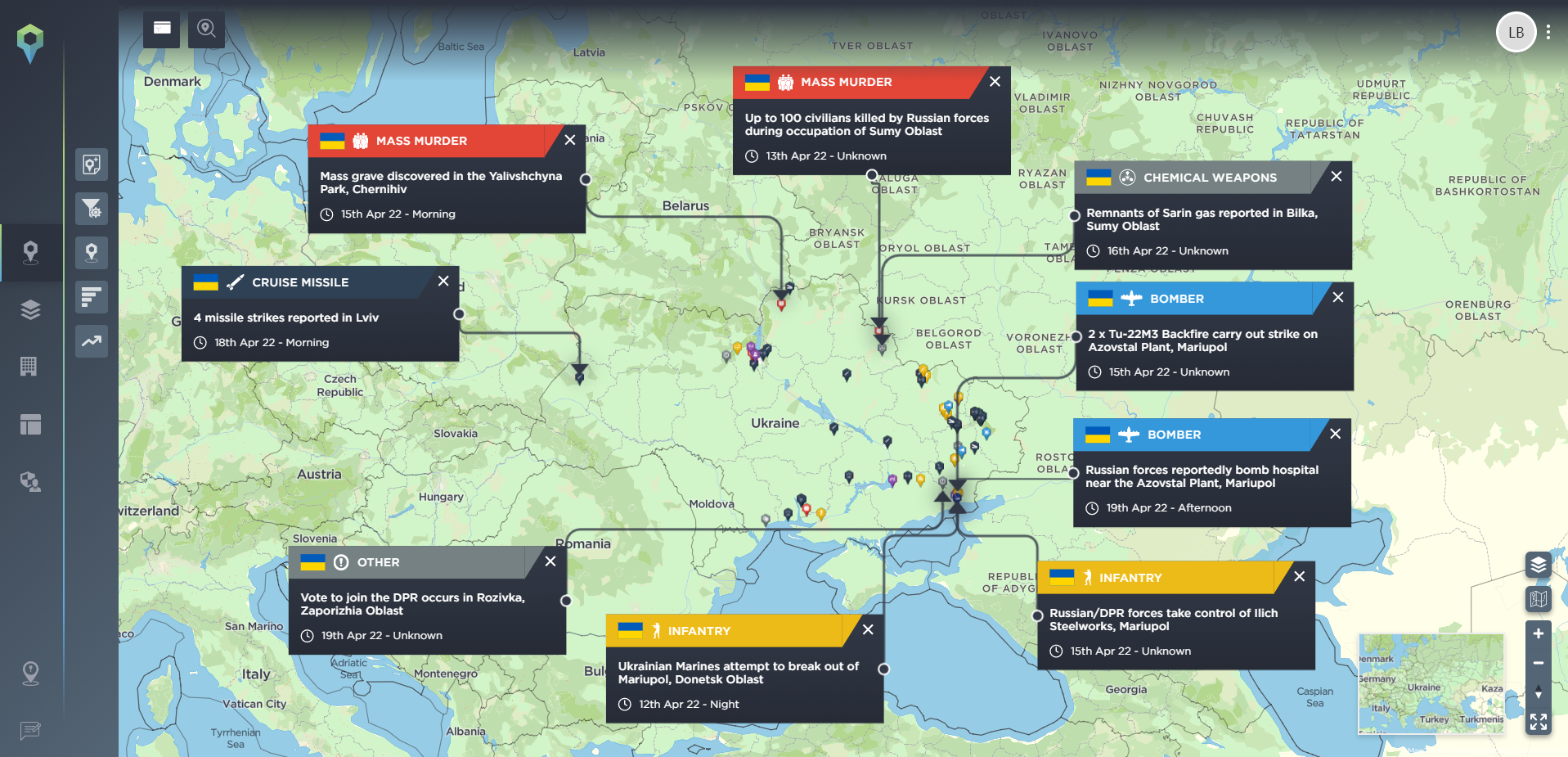
What is the international response to Russia's invasion of Ukraine?
As the conflict continues, the global impact of the Russia-Ukraine war cannot be ignored. In this section, we’ll document the international response to Russia’s invasion, the sanctions and repercussions Putin and his country face as well as the wider impacts that we’re witnessing across the world.
9th March 2022
International efforts to support Ukraine appear well-intentioned but ineffective or even self-defeating. A wave of anti-war protests in Russia – while supported internationally – has seen nothing but mass arrests over the weekend; a repeat of the pro-Navalny protests in 2021.
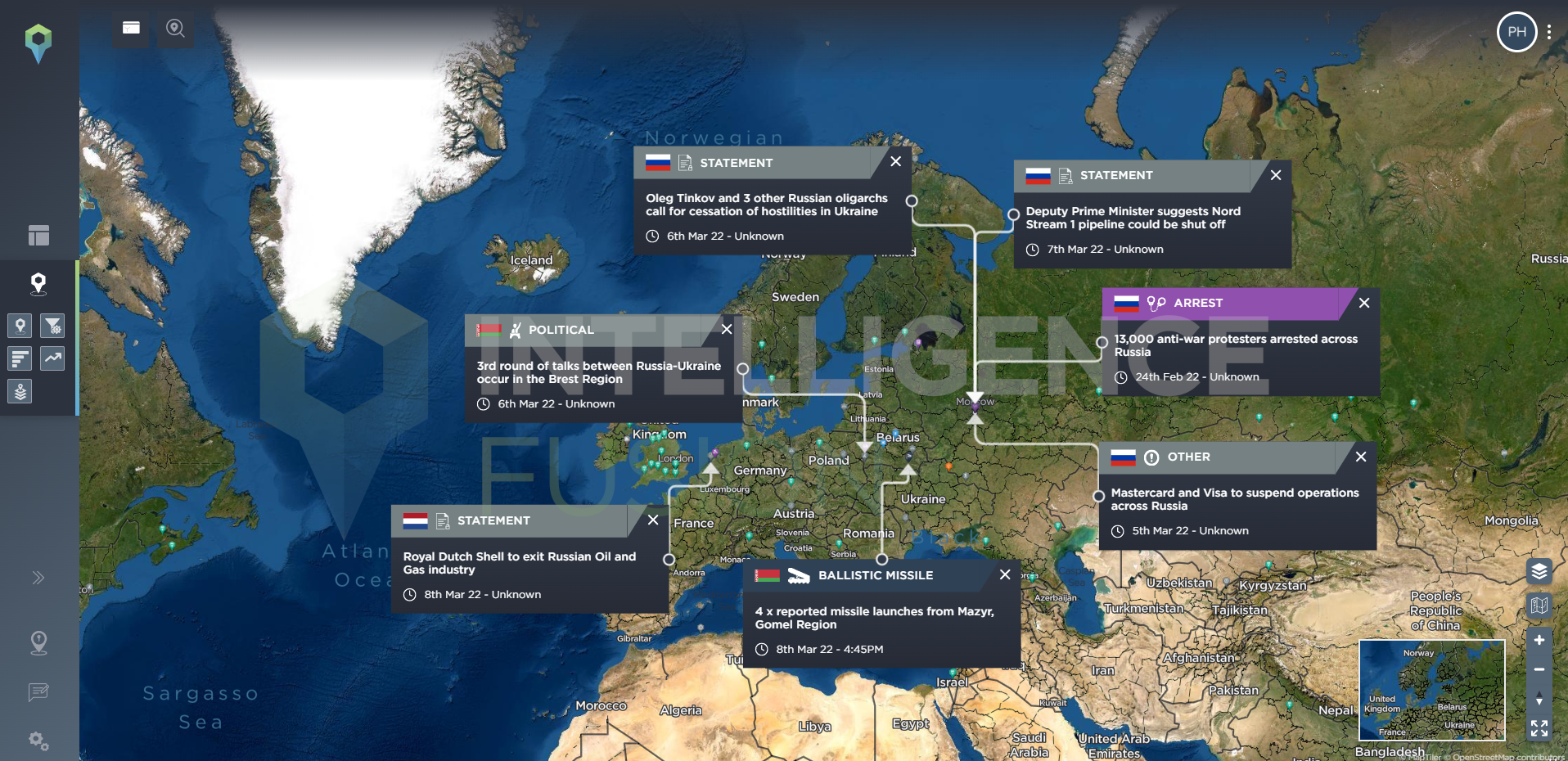
Significant activity outside of Ukraine demonstrates the wider impact of the Russian invasion of Ukraine, as of 9th March 2022.
Belarus has continued to provide a staging area for Russian aircraft and missile launches and hosted the third round of unsuccessful talks due to the terms of both sides being unpalatable to the other, Russia’s demands to Ukraine are clearly a non-starter to cease hostilities.
Sanctions and boycotts in Russia appear to have been having an effect on oligarchs but Russia has shown it continues to hold a major advantage: natural gas. Russian Deputy PM Novak’s veiled threat regarding Nord Stream 1 – combined with the current cessation of supply on the Yamal pipeline – would greatly reduce the supply of an economic centre of gravity, worsening an already growing problem of food security and other negative spillover effects. Efforts to access alternative supplies will not be able to immediately insulate the effect of shutting down Nord Stream 1.
The sanctions and boycotting of Russia appear to be having some effect but are unlikely to exert the sort of pressure necessary to cause Russia to re-evaluate its invasion of Ukraine. Furthermore, the Russian government does have options to react to such efforts which will likely make international efforts self-defeating in the long term; especially if the veiled threat of shutting off natural gas, even more, is acted on.
16th March 2022
Pro-Ukraine sentiment has continued, adding further weight to the effectiveness of Open Source reporting on the conflict and Ukrainian information operations. Many of the protests have echoed President Zelensky’s calls for a no-fly zone over Ukraine. While appealing, recent reports of S-400 Triumph Air Defence assets close to Ukraine’s borders in Belarus will make enforcing such a measure a complex task.
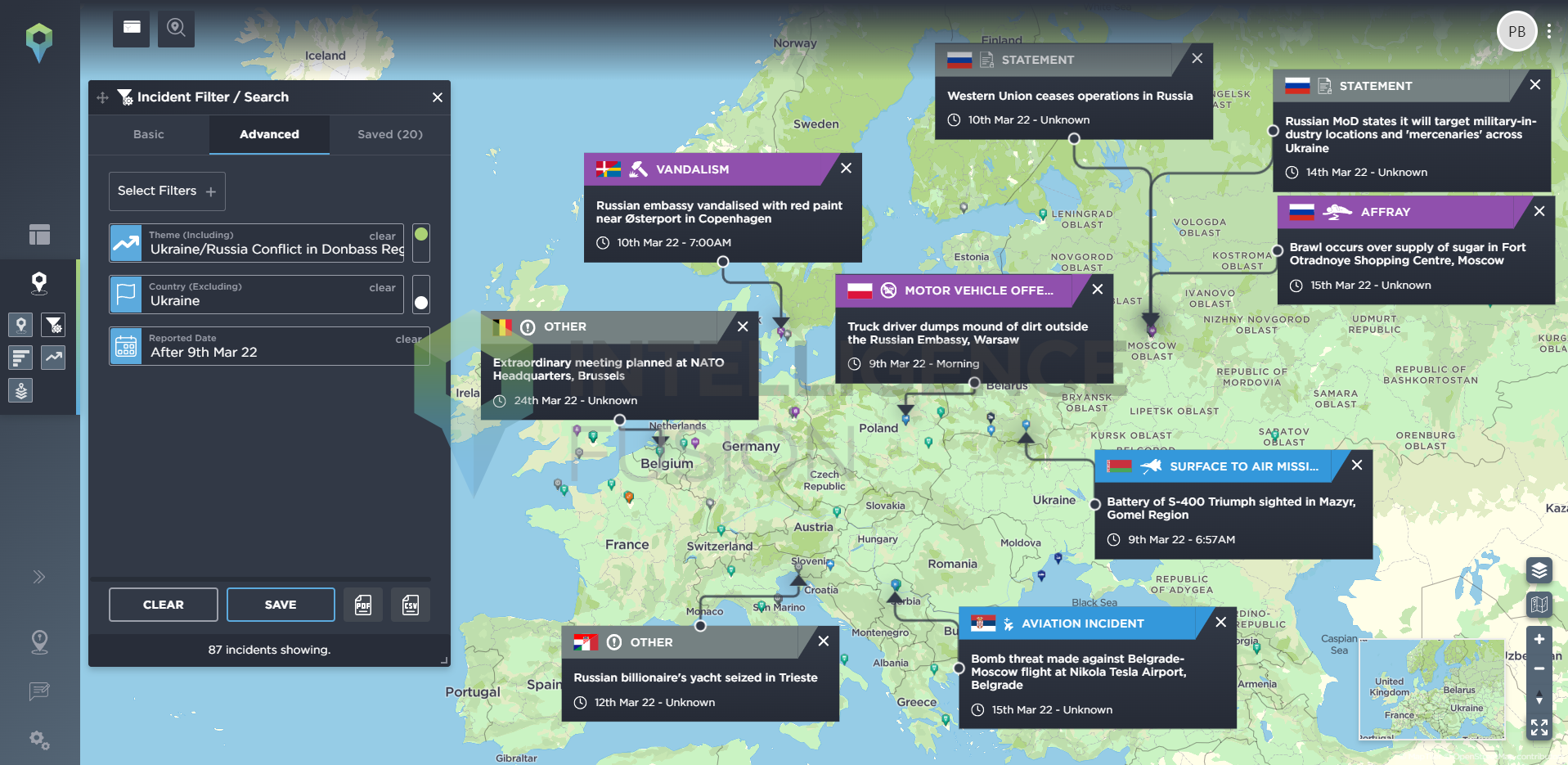
Significant incidents from across the world between the 9th and 16th March 2022, in relation to Russia’s ongoing invasion of Ukraine.
However, there have been indications of anti-Russian sentiment. Despite evidence of a sizable anti-war sentiment in Russia, there have been acts of vandalism against Russian businesses, embassies/consulates and cultural/education institutions. Of particular concern are the three recent false bomb threats being made against Air Serbia flights attempting to fly to Moscow from Belgrade.
These above sentiments have come as sanctions and boycotts continue to be imposed against Russian businesses across Europe. While there appear to be efforts to target Russian oligarchs, reports have suggested the sanctions/boycotts are increasing economic hardship within Russia; which may undermine anti-war efforts and boost Russian support for President Putin.
While targeting Russian oligarchs could have a positive effect, widespread boycotts and sanctions appear to be encouraging hostility against Russians in general. Should such efforts continue, acts of vandalism or other threats against Russian education/cultural institutions and businesses are likely to increase and will be noticed by Russians. Combining this with increased economic hardship may increase domestic support for President Putin, exacerbating an already turbulent situation.
23rd March 2022
Ukraine continues to enjoy widespread political and public support for its resistance against Russia’s invasion; with continued solidarity rallies, government sanctions, expulsions and asset seizures as well as commercial boycotts. Sanctions appear to have had an effect with Russia’s only manufacturer of main battle tanks – Uralvagonzavod – reportedly having to cease production; a potential contributor to the increase in Russia’s use of indirect weapons.
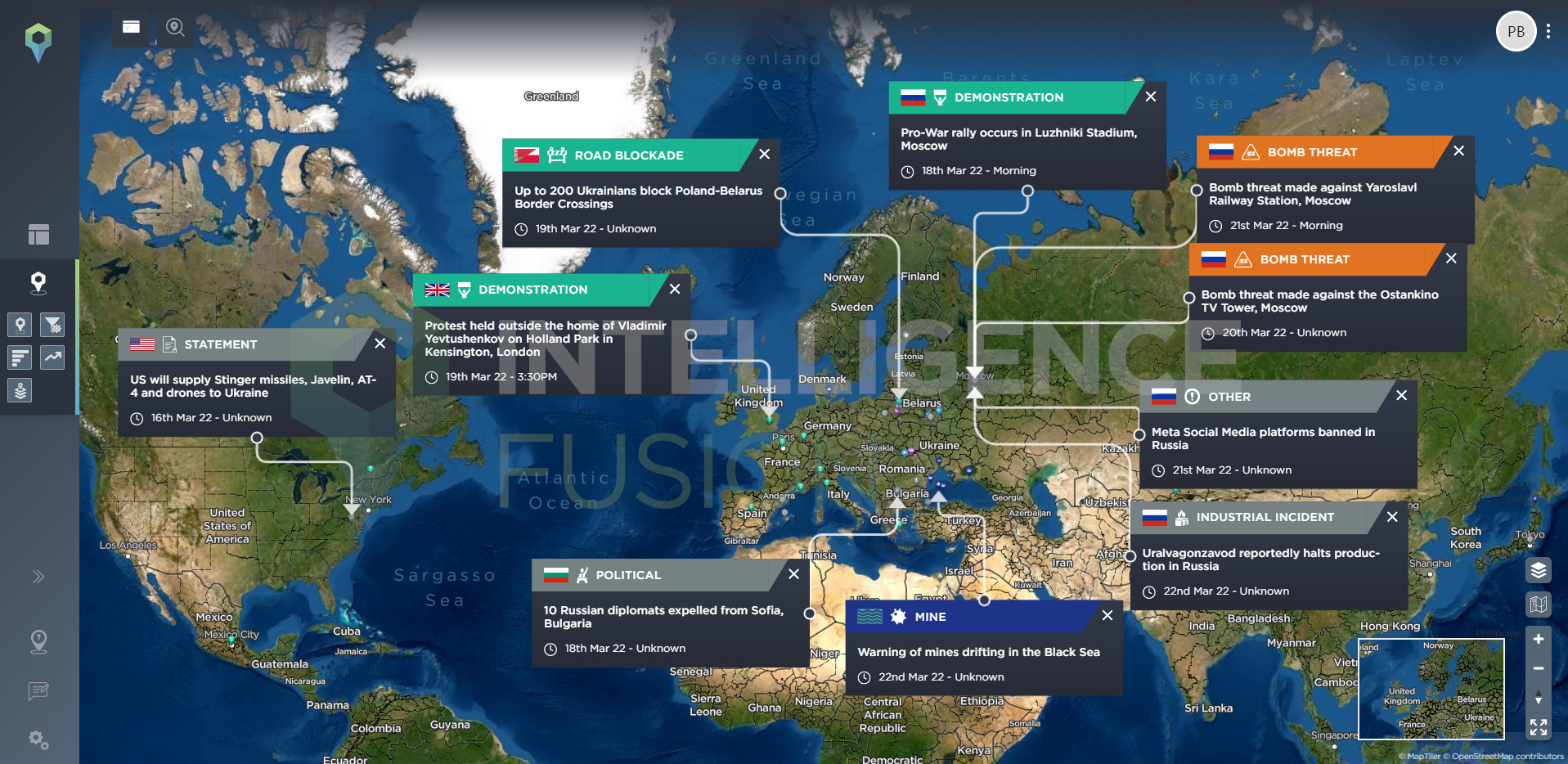
Significant incidents from across the world between the 16th and 23rd March 2022, in relation to Russia’s ongoing invasion of Ukraine.
Bulgaria has recently declared 10 diplomats ‘persona non grata’ (attracting veiled threats in return) and the United States will provide Stinger, AT-4 and Javelin missiles, ammunition and ‘Switchblade’ drones but yet has not assisted Poland in providing MiG-29 Fulcrum jets to Ukraine’s Air Force. International efforts appear focussed on longer term rather than immediate, noticeable effects. This may be to avoid potential reprisals from Russia in the form of cyber attacks which President Biden recently warned of.
Elsewhere, anti-war protests appear to have reduced/gone unnoticed in Russia due to the mass arrests which have occurred in recent weeks. Anti-war efforts could be turning to alternative tactics of false bomb threats. While unconfirmed, this tactic was used to protest Russia’s recent intervention in Kazakhstan. Belarus continues to provide a staging area for Russian forces but is also showing signs of increased human trafficking along its border with Poland; recent border crossing attempts by African and Middle Eastern (likely of fighting age) males have featured assistance by Belarusian soldiers in hindering Polish Border Guards.
International support appears to be focussing on efforts which will have longer term, less immediately noticeable effects and may intend on creating an insurgency campaign. While such efforts may have a greater impact in time, Russia has options to push back. Among them being tit-for-tat diplomatic responses and encouraging Belarus to resume its human trafficking efforts along Poland’s border. This will exacerbate an already significant humanitarian problem with Ukrainians fleeing the war and possibly discourage future European support for Ukraine because of potential spill over effects from mass immigration of Middle Eastern and African migrants into Europe. Furthermore, a focus on long term effects by the international community could potentially cede control of the short term to Russia, which could encourage Russian forces to rapidly increase their attacks and end the war before further effects of international efforts materialise.
30th March 2022
International support for Ukraine has continued over the last week although it appears some activist groups have been using the war to promote their own agenda. On 25th March, numerous climate change groups gathered for an annual Climate Strike to demand an end to fossil fuel energy. Groups like Fridays For Future have claimed that without Europe’s reliance on oil and gas, Russia would not have the ability to keep fighting in Ukraine. Greenpeace has also carried out a direct action against a Russian oil tanker.
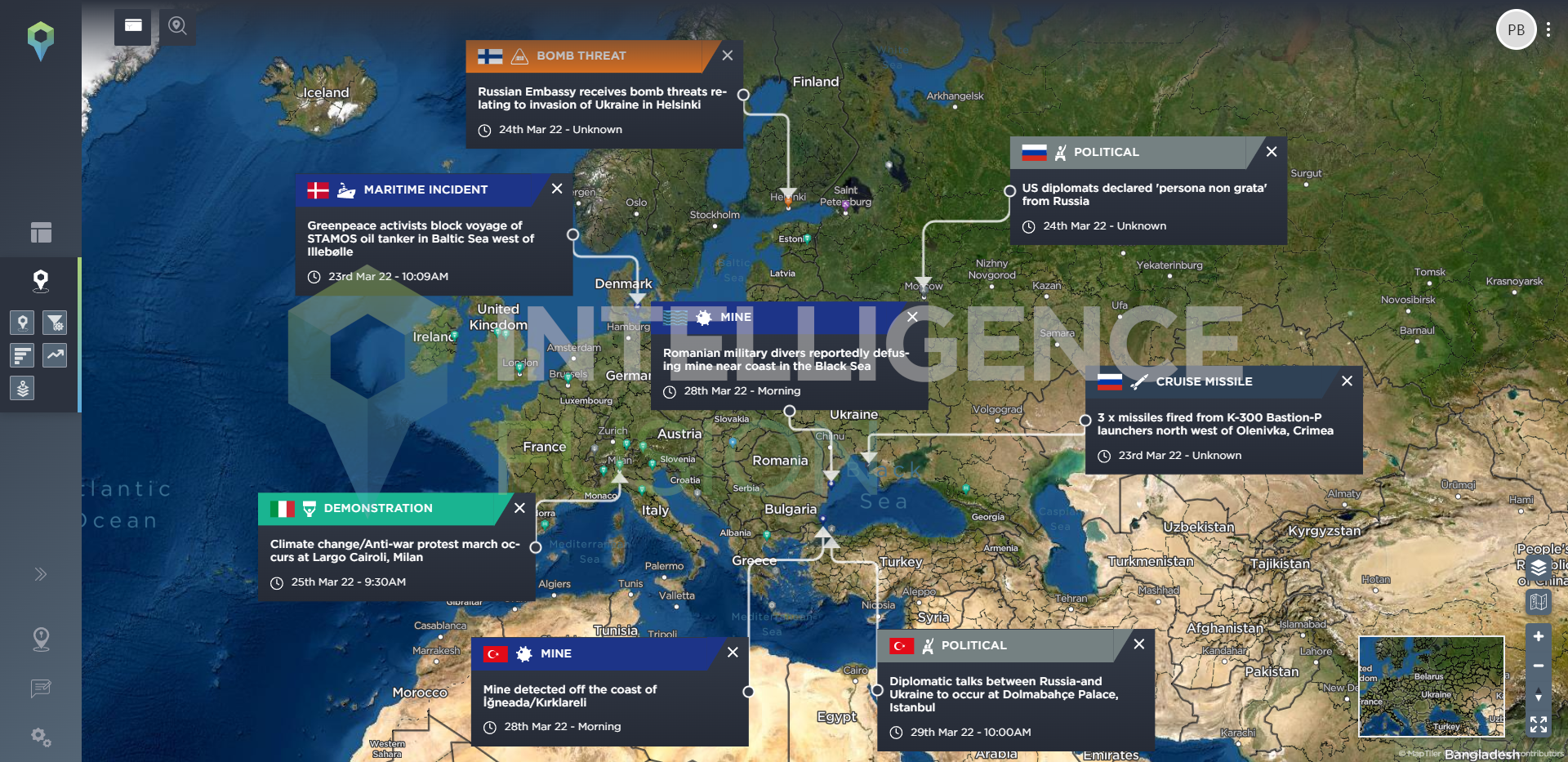
Significant incidents from across the world between the 24th and 30th March 2022, in relation to Russia’s ongoing invasion of Ukraine.
Anti-Russia sentiment appears to have reduced but remains problematic, with continued incidents of threats against Russian embassies.
Additionally, anti-ship mines appear to be becoming a problem in the Black Sea, with at least two incidents of mines drifting south towards Turkey, Bulgaria and Romania.
Diplomatic talks between Russia and Ukraine have resumed in Istanbul and reports have suggested small areas of common ground in addition to Russia’s change in focus towards the Donbass region. However, during these talks Russian forces have continued their attacks in Ukraine (from outside the country as well as within it) as well as responding in kind to recent expulsions of their diplomat.
Going forward, international support for Ukraine will continue but it may become a means to promote other agendas. Climate change activist groups will be keen to reiterate demands for renewable energy policies with the justification that doing so will end dependency on Russian energy and thus end the war. Elsewhere, the war in Ukraine appears to be creating problems for shipping in the Black Sea. Anti-ship mines becoming untethered and adrift will likely pose a similar issue to land mines/unexploded ordnance; increasing the need for maritime shipping in the Black Sea to be on the lookout for these explosives for several years.
6th April 2022
Russia has vehemently denied accusations of committing war crimes in the wake of the discoveries in Bucha, claiming it to have been orchestrated by Ukrainian forces. Prior to the discoveries in Bucha, reports in Russia had been focussing on alleged Ukrainian attacks on infrastructure in Belgorod, one of which was reported to be Ukrainian Mi-24 helicopters attacking a Rosneft oil depot. Given Ukraine’s scarce air capabilities and prior missile attacks against military targets, Russian claims of Ukrainian helicopter attacks on its territory let alone an oil depot are doubtful. Nonetheless, President Putin appears to have decreed a further 134,500 men are to be conscripted. Furthermore, no reports have been found on any progress being made with diplomatic peace talks in Istanbul.
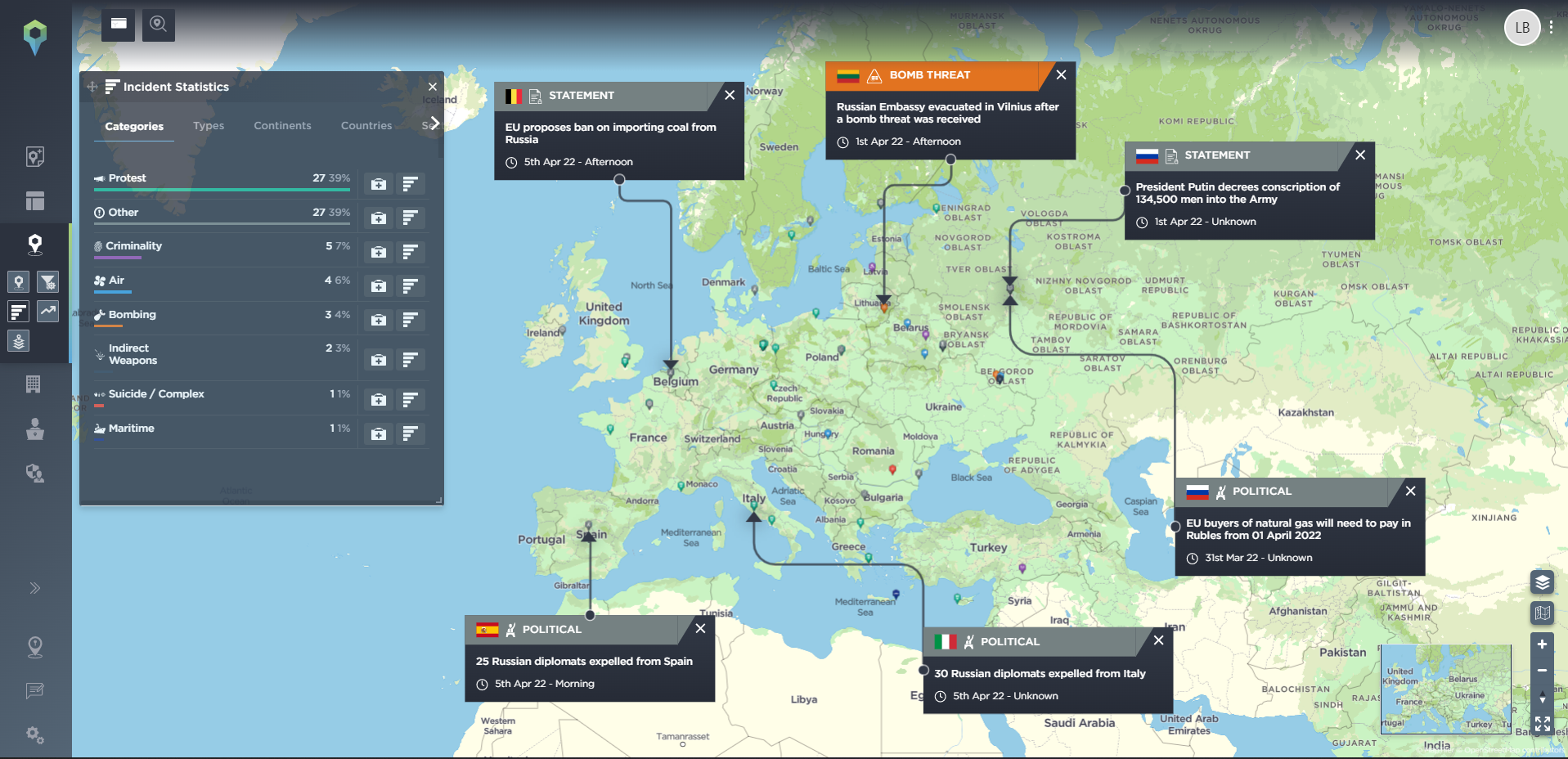
Significant incidents from across the world between the 31st March and 6th April 2022, in relation to Russia’s ongoing invasion of Ukraine.
Political, economic and social hostility towards Russia has increased significantly in the wake of the discoveries in Bucha. Numerous European countries have expelled large numbers of Russian diplomats, further economic sanctions are being proposed, assets continue to be seized and anti-Russia protests, boycotts and threats against Russian businesses/institutions have continued. At the time of this report, an attack appears to have occurred on a Russian embassy in Bucharest, Romania. These activities are now seeing Pro-Russia/anti-discrimination sentiments emerge from the Russian diaspora in Europe.
Anti-Russia sentiment has the potential to increase dramatically in the wake of recent events. More expulsions, protests, sanctions and boycotts can be expected and even direct attacks on Russian businesses/institutions can be anticipated. Whether justified or not, it could encourage an increase in domestic nationalism and support for the Russian government as a reaction. Such escalations could potentially lead to social unrest and rioting should anti and pro-Russia rallies come into contact.
13th April
International condemnation, sanctions and even taunting of Russia have continued as more information comes to light regarding atrocities committed West of Kyiv. In response, Russian officials are showing a united front against criticism, the Russian government has been quick to respond in kind to the expulsion of diplomats and has warned/threatened European states looking to join NATO.
This polarised state of affairs has continued to spill over into the public sphere and is potentially intensifying. There have been pro-Ukraine and pro-Russia protests, alleged cyberattacks by ‘hacktivists,’ attacks on Russian-owned properties and an attack on the Russian Embassy in Bucharest (although the perpetrator appears to have ulterior motives).
Of major concern is new information on the explosion at Rosneft’s Oil Depot in Belgorod. Video footage of the incident showed Mi-24 helicopters firing rockets on the facility, but this may have actually been an attempt to extinguish the fire by setting off explosions in order to deprive the blaze of oxygen (and simultaneously provides a narrative of Ukraine conducting airstrikes on Russia). However, reporting from credible sources on cybercrime and cyber-attacks has suggested Ukraine attacked the Gazprom IT infrastructure controlling the pressure at this depot, causing the explosion. Such a scenario is possible; in fact, Russia has been linked to less intense – but nonetheless damaging – attacks on European and American infrastructure. If true, such an attack is an escalation – even for defending against Russia – and will have wider impacts.
Outside of Ukraine, there is growing potential for the war to escalate. Sanctions, diplomatic expulsions, condemnation and taunting are likely to continue. Such activities – justified or not – will continue to spill over and intensify what appears to be growing hostility toward Russians. Such hostility will soon encourage reactions – justified or not – and lead to unrest amongst the Russian and Ukrainian diasporas.
Furthermore, there is potential for escalation of cyberattacks against infrastructure. If the claims of the Rosneft facility explosion being caused by a cyber attack are true, a retaliation by Russia can be anticipated, which will demand a retaliation in return. Such activities will have significant consequences across Europe and could exacerbate already growing tensions towards Russian and Ukrainian communities abroad.
20th April
Attempted Russian counter-claims to hide a humiliating loss for the Black Sea Fleet (the sinking of the flagship missile cruiser ‘Moskva’) have been largely unsuccessful and regardless of whether it was destroyed or sank in an accident, a significant attack and command and control node has been lost in Russia’s war effort. Additionally, this appears to be the second loss of a Russian Navy vessel by Ukrainian attacks from its shores.
Nonetheless, Russia appears intent on continuing its invasion. Statements by President Putin and Foreign Minister Lavrov support reports from within Eastern Ukraine that a new offensive is underway and for the time being, no potential exists for any kind of agreement to be made to end the war. Additionally, Russia has been making several claims of Ukrainian attacks on Russian territory; but these appear to lack credibility. Considering the sinking of the Moskva and developments in Russia, the new offensive in Eastern Ukraine will be necessary for Russia to regain the initiative. This will require attacks that are intense, inflict heavy losses and are rapidly successful.
The fighting which will occur is going to be intense and will probably see more incidents of civilian casualties from previous reports. Such intensity will likely require more international support for Ukraine and as this continues, divisions which are becoming more noticeable are likely to widen which will increase the chances of unrest breaking out.
How did the Russia-Ukraine conflict start?
This Russian build-up on the Ukraine border has coincided with both the Poland-Belarus border crisis and Russia’s attempts to double its supply of natural gas to Western Europe through the Nord Stream 2 pipeline. To further understand the context surrounding the troop build-up, we have included our prior analysis on both of these issues below – as well as the significance of the Russia-Ukraine conflict for Ukraine’s Oil and Gas economy.
The Russia-Ukraine Conflict and the Poland-Belarus Border Crisis
Prior to the invasion, the most recent build-up of Russian military assets on the Ukraine border coincided with the Poland-Belarus border crisis, with Belarus – an ally of Russia, although by no means a ‘puppet state’ – accused of state-sponsored human trafficking.
In our analysis of 17th November 2021, we wrote:
“Reports since October have since shown growing indications of this human trafficking being state-sponsored… Since November, the intensity of Belarusian activity has increased, with migrants being pushed towards the Kuznica checkpoint and groups of migrants now trying to directly engage Polish patrols along the border.
“On the surface, this state-sponsored human trafficking is highly likely to be Belarus’ response to EU sanctions against Belarus following last year’s election; the intention appears to be to pressure the EU to remove the sanctions it has imposed on Belarusian officials and businesses.”
The timing of the escalation in the Poland-Belarus border crisis also coincided with the increase in Russia’s military deployments on the Ukraine border. In our further analysis dated the 24th November, we noted:
“Belarus’ actions have provided an opportunity for Russia to exploit the Donbass region. The border crisis which has been created appears to have focussed attention on Poland, providing misdirection that makes it easier for Russia to position military assets along its territories bordering Ukraine with fewer chances of being noticed. Additionally, this misdirection has made it easier for the Russia-backed elements in Donbass to increase their efforts to provoke a retaliation from Ukrainian forces.
Should there be more instances of largely attempted border crossings into Poland and/or the set up of another migrant camp like what was seen near Kuznica, the ceasefire violations will likely intensify across the Donbass frontlines, with more use of artillery and even armour in Donetsk and Luhansk Oblasts.”
The Russia-Ukraine Conflict and the Nord Stream 2 Gas Pipeline
At the same time, Russia had completed construction of the Nord Stream 2 gas pipeline, which would provide natural gas directly to Western Europe via Germany. The certification process for this pipeline has yet to be completed, however, with Germany suspending approval on the 16th November, likely in some part in response to Belarus’ threat to halt gas supplies from the Yamal pipeline.
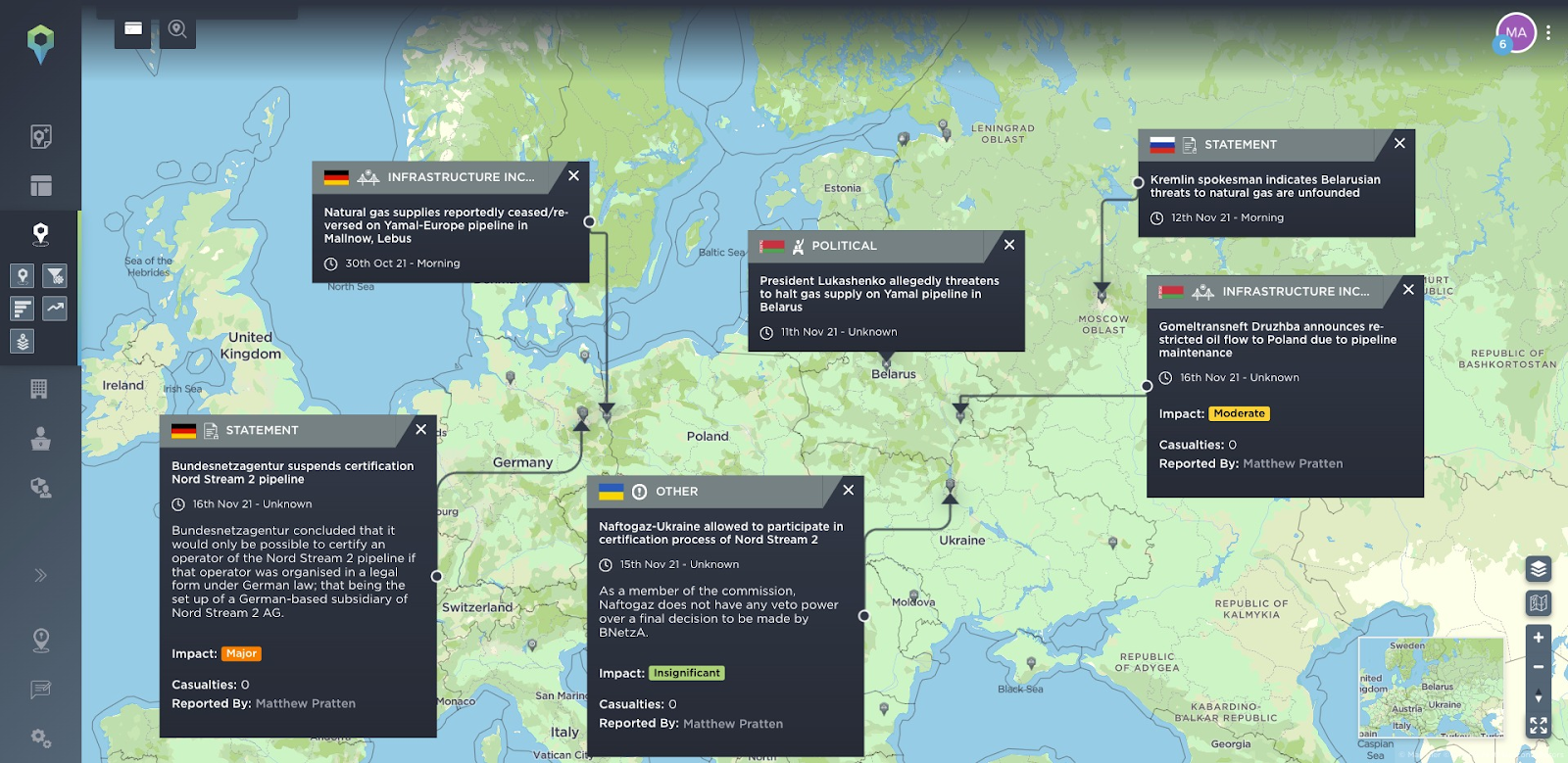
Incidents relating to Nord Stream 2 and the Poland-Belarus border as of 24th November 2021 [Source: Intelligence Fusion]
“Approval of the pipeline would increase Russia’s Diplomatic Information Military and Economic (DIME) instruments over Europe by enabling Russia to apply economic pressure over European gas supplies.
“While current supplies of Russian natural gas via Gazprom (and increased supply should the Nord Stream 2 pipeline become operational) come with reliance and resilience, it needs to be repeated that because Gazprom is largely owned by the Russian government, it is heavily influenced by their own interests. Currently, there have been indications of Russia acting in a hostile manner to Eastern Europe by undermining natural gas supplies (the most significant being recent events in Moldova) and the occupied areas of Donbass and Crimea by Russia backed proxies contain vital oil and gas resources to Ukraine’s economy.
“With an operational Nord Stream 2 pipeline, such actions by Russia could occur in an even more favourable situation to them. Should Russia want more favourable conditions or treatment from Western Europe, it can cut supplies from the Baltic and Black Seas which force gas supplies to come via Eastern Europe, which will come with higher prices due to transit fees. Should Russia want the same from Eastern Europe, it can simply cut supplies via overland routes while still selling natural gas to Western Europe via the Baltic and Black Seas. With the Nord Stream 2 pipeline, Russia has an element of strategic depth for its Economic instruments of power; which could spill over into providing strategic depth for its Diplomatic, Information and Military instruments too.
“With the ability to simply threaten to reduce or cut off natural gas supplies, it is likely that Russia would be able to continue its ongoing acts of espionage, disinformation efforts, and even increase the attacks against Ukrainian forces in the Donbass region.”
In a recent episode of The Insight video series, Senior Regional Analyst for Europe Matt Pratten explained the economic advantage that Nord Stream 2 would give Russia over the European continent.
Similar warnings came from the UK government, with Foreign Secretary Liz Truss and Prime Minister Boris Johnson both drawing direct connections with the pipeline and the situation in Ukraine. It is highly likely that the economic consequences that President Biden has warned of would aim to include Nord Stream 2, a pipeline that the US is already opposed to.
Update 23rd February 2022: On 22nd February 2022, German Chancellor Olaf Scholz announced that the government was pausing the certification of the Nord Stream 2 pipeline in response to Russia’s recognition of the LPR and DPR and order to send in troops as a peacekeeping force.
The Russia-Ukraine Conflict, Oil and Gas and the Energy Sector
Click to expand and read our prior analysis of the Russia-Ukraine conflict and its impact on Oil and Gas, originally published on 23rd August 2021.
Ukraine has immense potential for investment with its vast oil and gas resources, ranking second across Europe for gas reserves. Shown in Figure 3 below, these resources are divided into three major regions: the Dnipro-Donetsk basin, the Carpathian region in western Ukraine, and the Black Sea and Crimea region. The Dnipro-Donetsk basin holds the majority of these resources. In terms of production, natural gas takes up 89%, oil 7.9% and gas condensate takes up 3.1% in terms of hydrocarbon production. (U.S. Department of Commerce, 2021; Renkin, 2019; The Energy Consulting Group, 2015).
Consequently, the Ukrainian government considers the oil and gas industry as a strategic sector; with the majority of production belonging to state-owned companies accounting for approximately 74%, domestic private firms accounting for 18% and other private firms accounting for 3% of production. Additionally, Ukraine has numerous pipelines enabling Russian oil and gas to be pumped into Europe via Ukraine as shown in Figure 4. Ukraine receives an approximate US$1.5 billion in transit fees from Russian gas being pumped through these transmission lines (Renkin, 2019; Intelligence Fusion, 2021; Schuler, 2014; Yermolenko and Panchenko, 2021).
COMMENT. Russia’s invasion and continued possession of the Donbass region and the Crimea Peninsula since March 2014 has subsequently caused significant, strategic level damage to Ukraine’s economy. Looking at Figures 5 and 6, the fighting between Ukraine and the DPR/LPR in the southern edges of the Dnipro-Donetsk basin, along with its proximity to Russia-Ukraine borders would appear to deny Ukraine the full use of its largest oil and gas basin. Furthermore, the possession of Crimea by Russia would appear to deny Ukraine access to its Crimea Oil and Gas basin as well as use of its Deepwater Licences due to the risk of Russian naval activity in the Black Sea.
Adding to the above problems is the impact of Russia’s invasion on foreign direct investment (FDI) in the industry. After the conflict began in 2014, oil and gas firms Royal Dutch Shell and Chevron withdrew their investments in the Yuzovsky and Olesska shale gas blocks, affecting even the Carpathian basin despite it being insulated from the fighting. As shown in Figures 4-6, the withdrawal of these investments has amplified the impact of losing the Dnipro-Donetsk basin and the Crimea basin (Cunningham, 2014; Russia Today, 2015; Alexeev, 2014; Central Intelligence Agency, 2021; Intelligence Fusion, 2021).
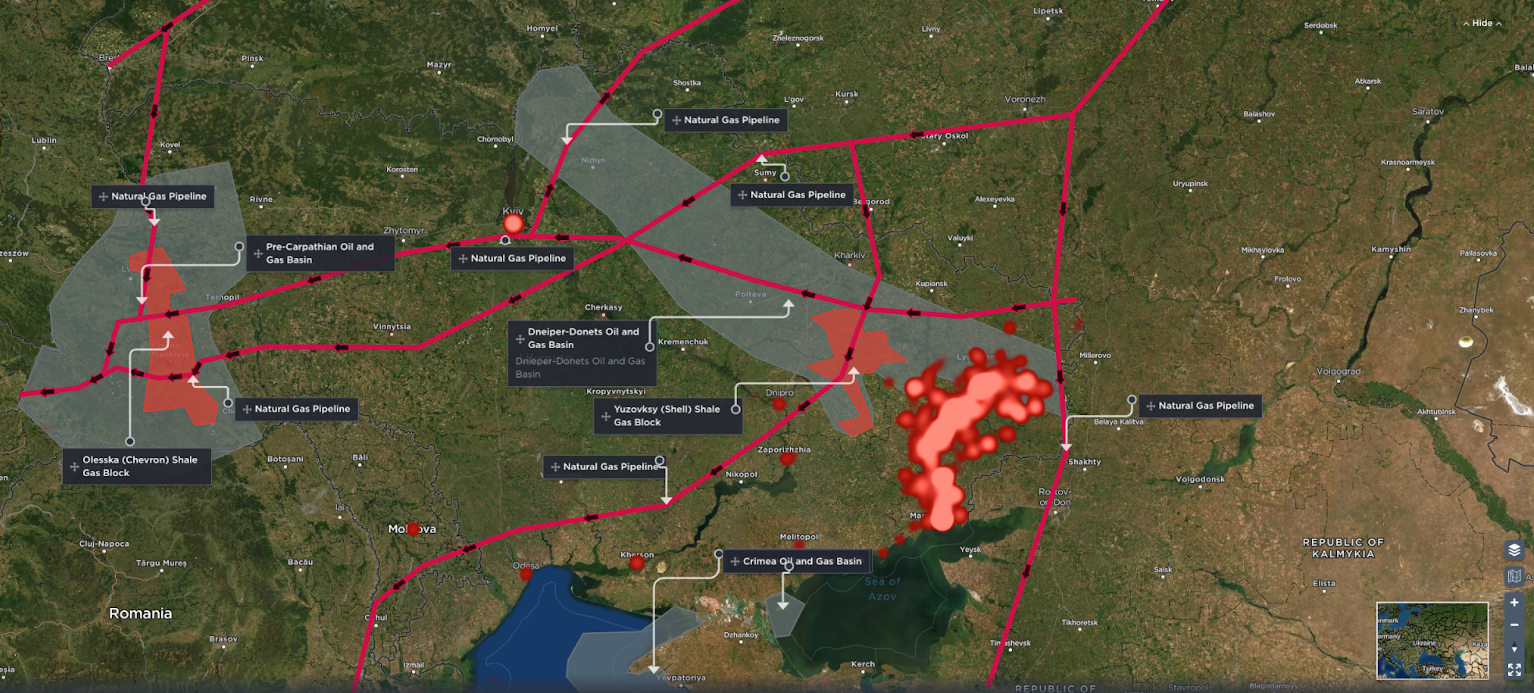
Figure 5: Updated Donbass conflict hotspots, oil and gas resources and major gas transmission lines [Source: Intelligence Fusion, Outside the Beltway Blog and The Energy Consulting Group]
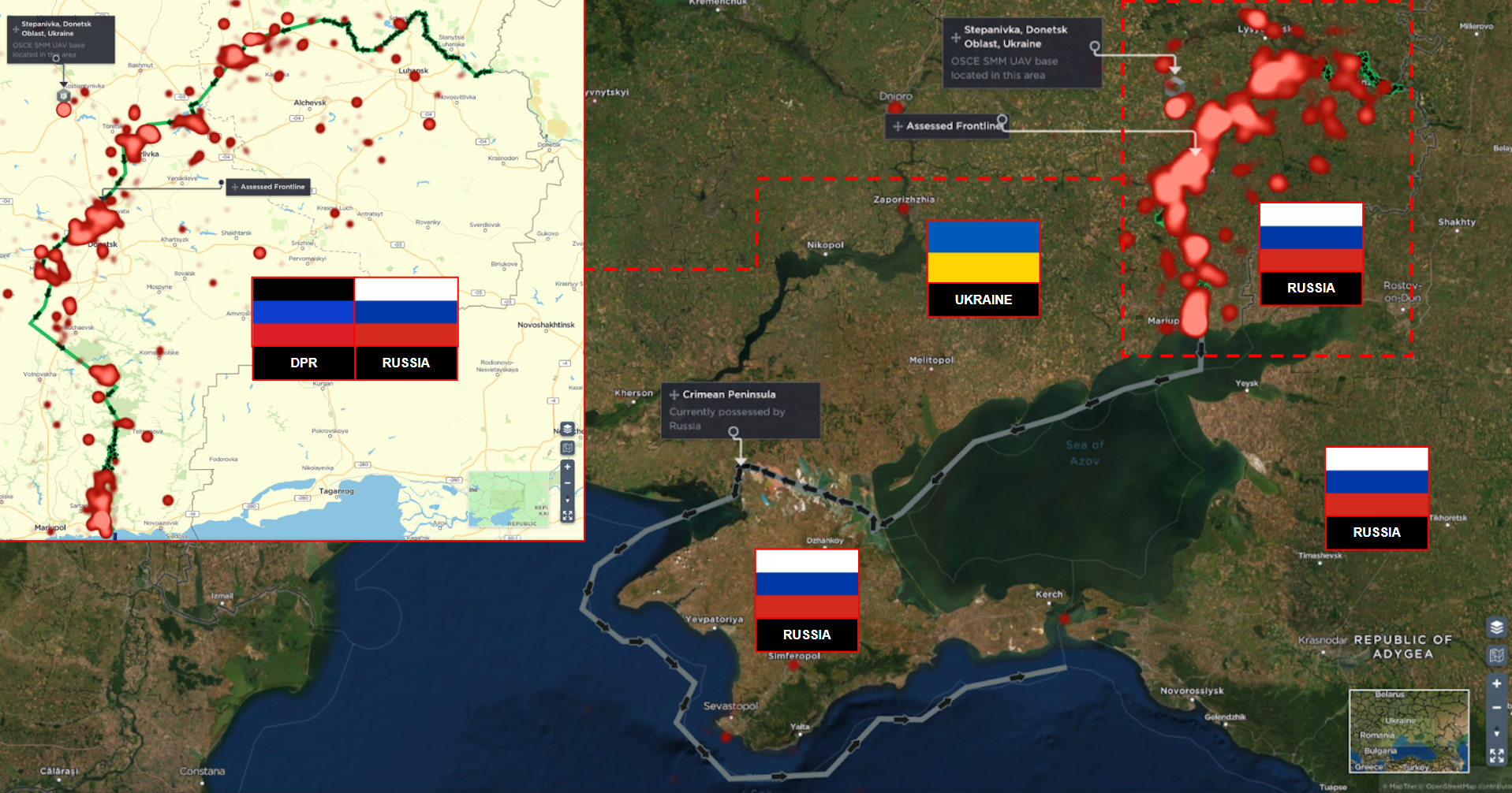
Figure 6: Donbass conflict hotspots and controlled territories [Source: Intelligence Fusion]
Adding to this problem is reporting which indicates that from 2024, Russia could end its contracts with pumping gas through Ukraine – denying Ukraine billions in revenue – based on the upcoming completion of the Nord Stream 2 pipeline which will bypass Eastern Europe, rendering many of the current pipelines largely irrelevant to Russia’s economic interests. Alternative pipelines via the Baltic and Black Seas already make it easier for Russia to bolster its control of the Donbass region since damage or loss of pipelines can be mitigated by pipelines elsewhere: with an operational Nord Stream 2 pipeline, such actions by Russia could occur in an even more favourable situation to them. COMMENT ENDS
As noted in our analysis of 5th November 2021, the completion of Nord Stream 2 also gives Russia an economic advantage over the European continent, mitigating any further potential economic sanctions that could be imposed following any military aggression on its part. In fact, by providing redundancy to its supplies to Europe, the pipeline affords Russia economic leverage, allowing them to potentially cut supplies of natural gas – or threaten to do so – in order to gain favourable conditions, or ward off potential retaliation, without causing too much damage to its own economic interests.
Intelligence Fusion’s Russia-Ukraine conflict summary is made possible by our 24/7 team of experienced, military-standard trained intelligence analysts, who use open-source intelligence sources to track, verify, map, and analyse the latest developments across the global threat landscape.
As the situation continues to develop, we will be posting regular updates as well as answering any questions people might have about the conflict in the Donbass region on our Twitter channel.
If you’d like to find out more about how our threat intelligence platform can help your security team, schedule a demo today.
About the author
Philip Buckingham
